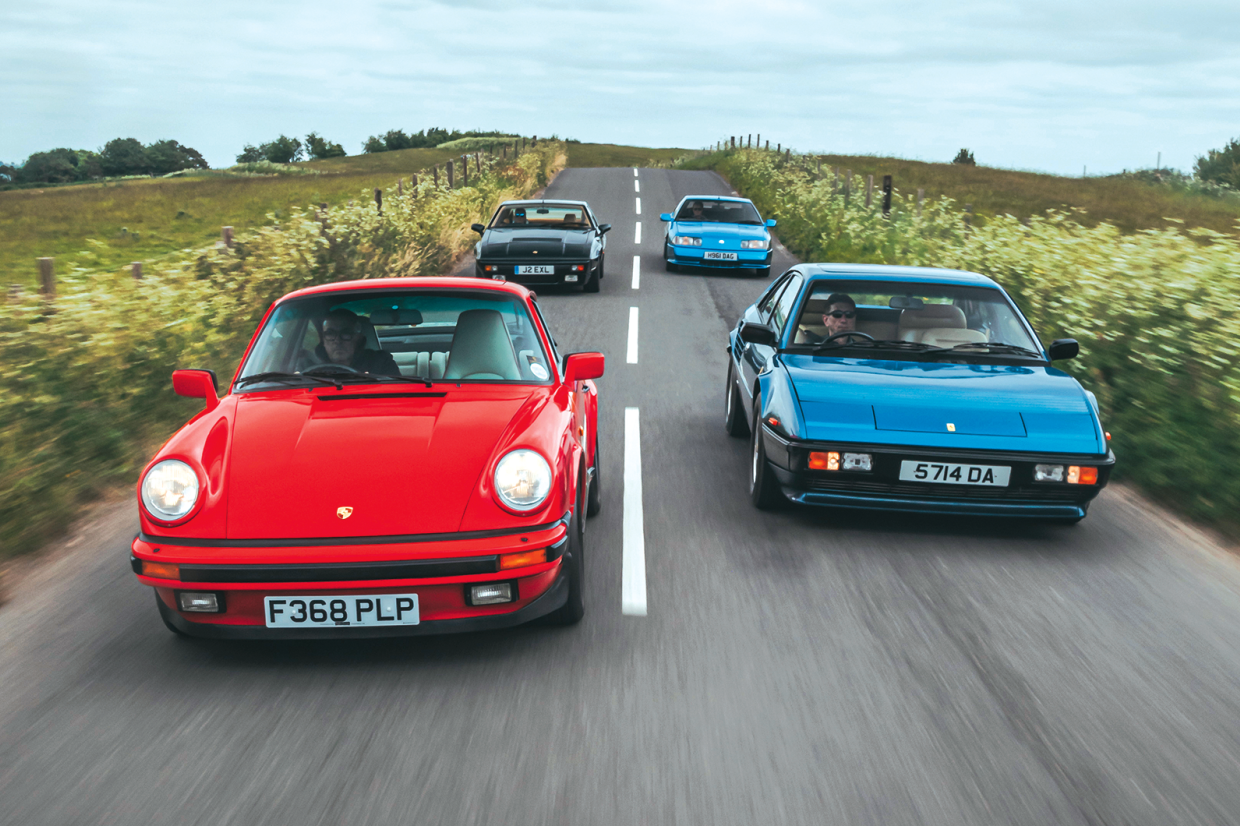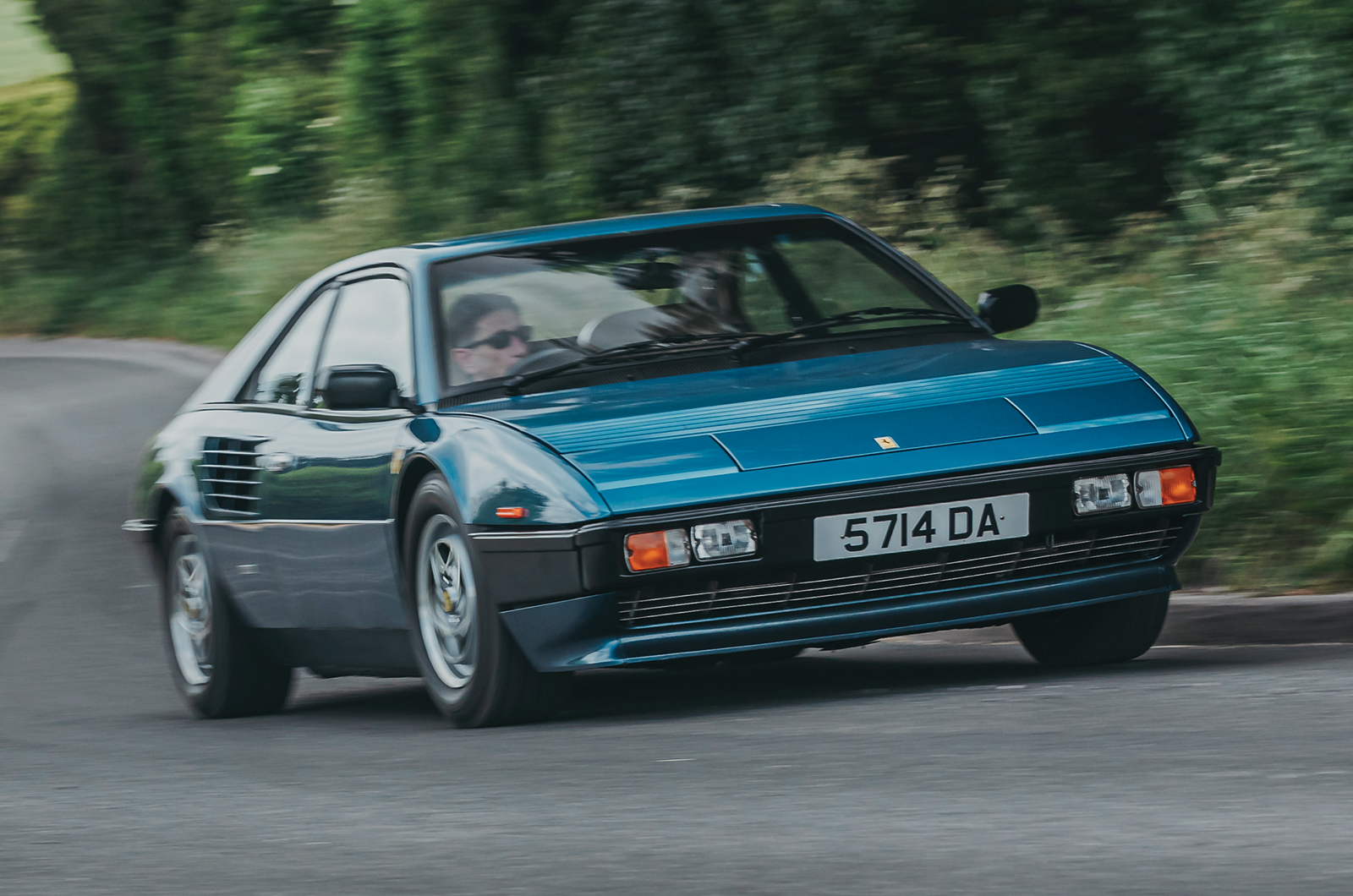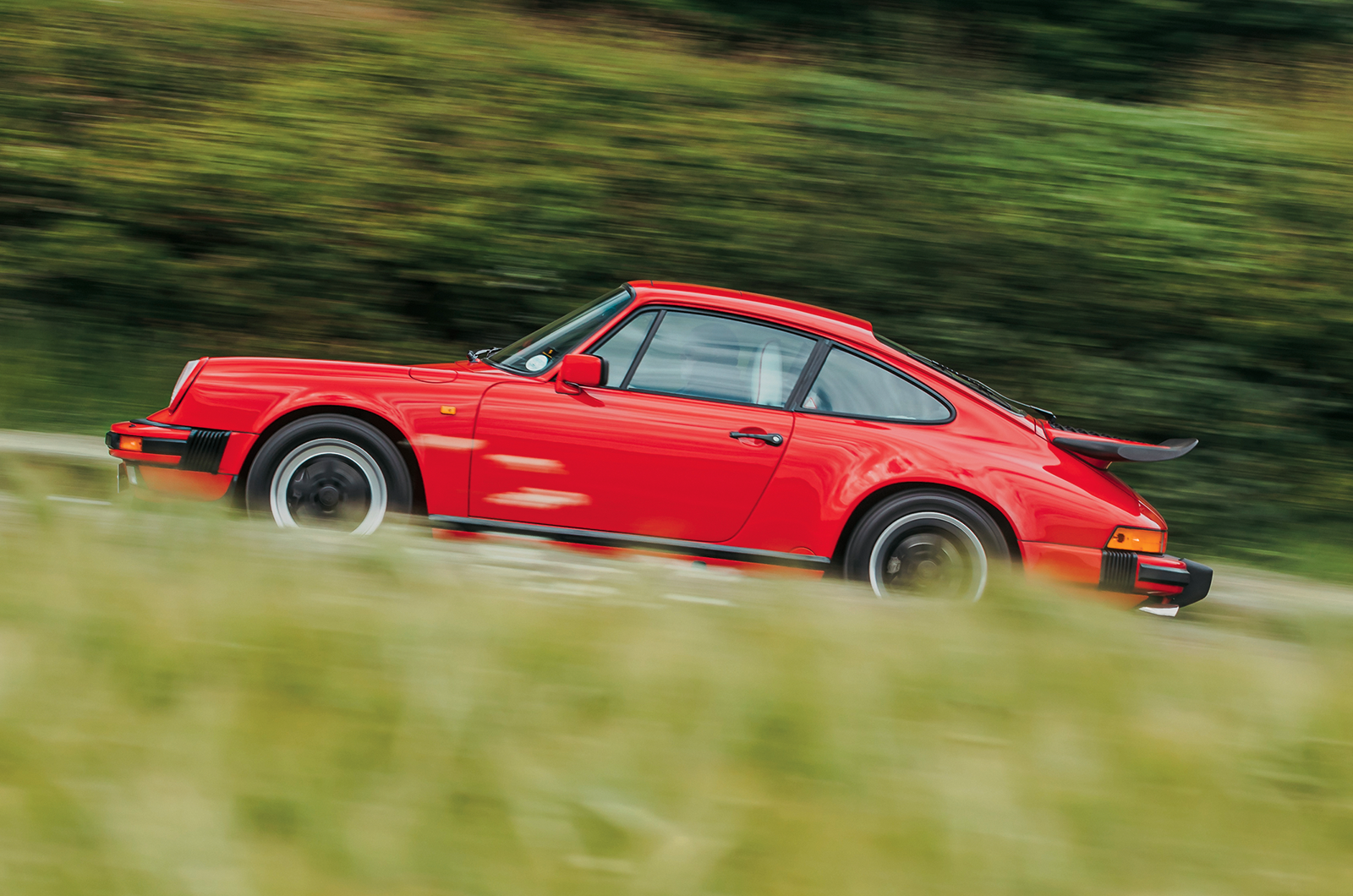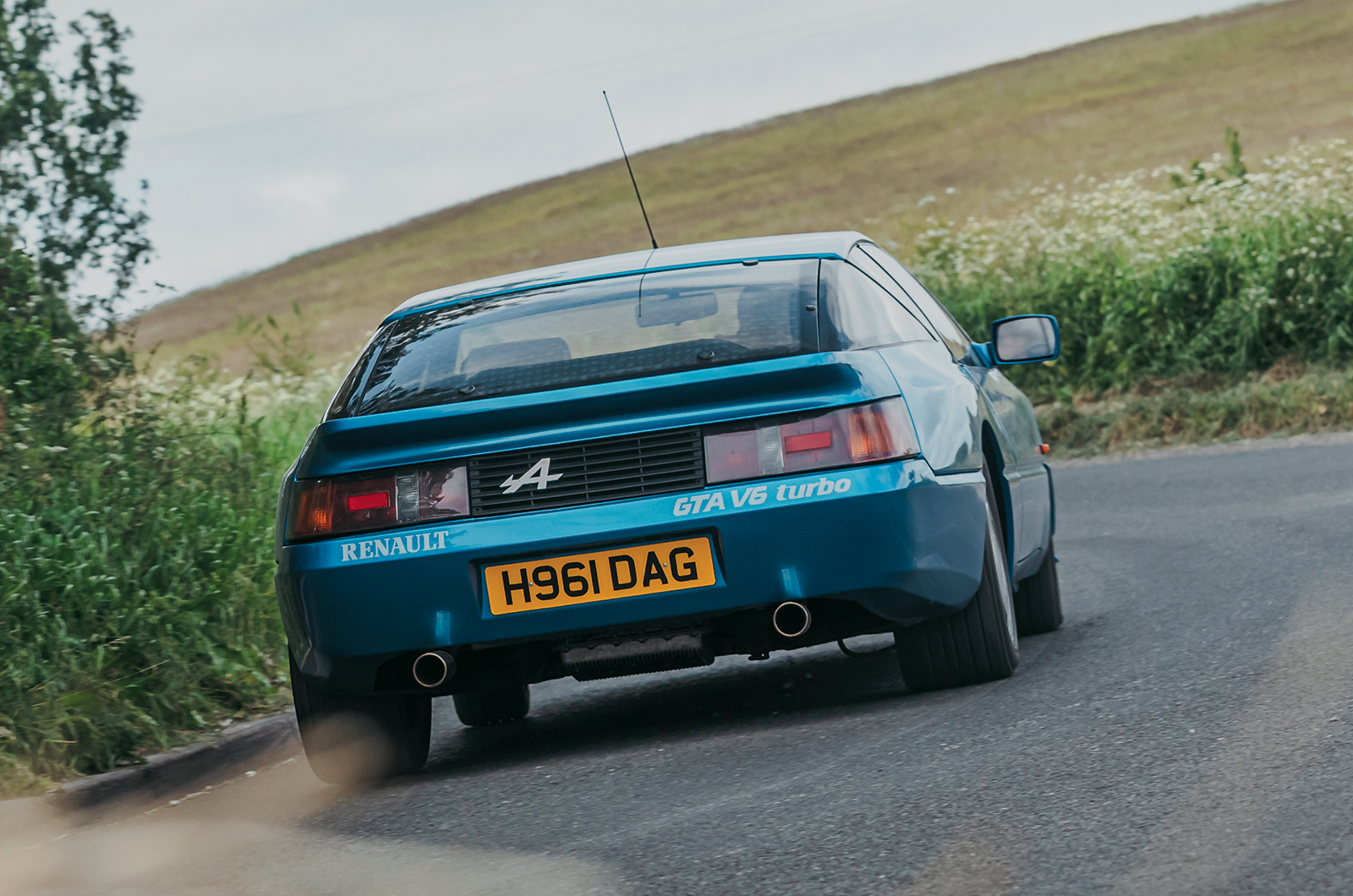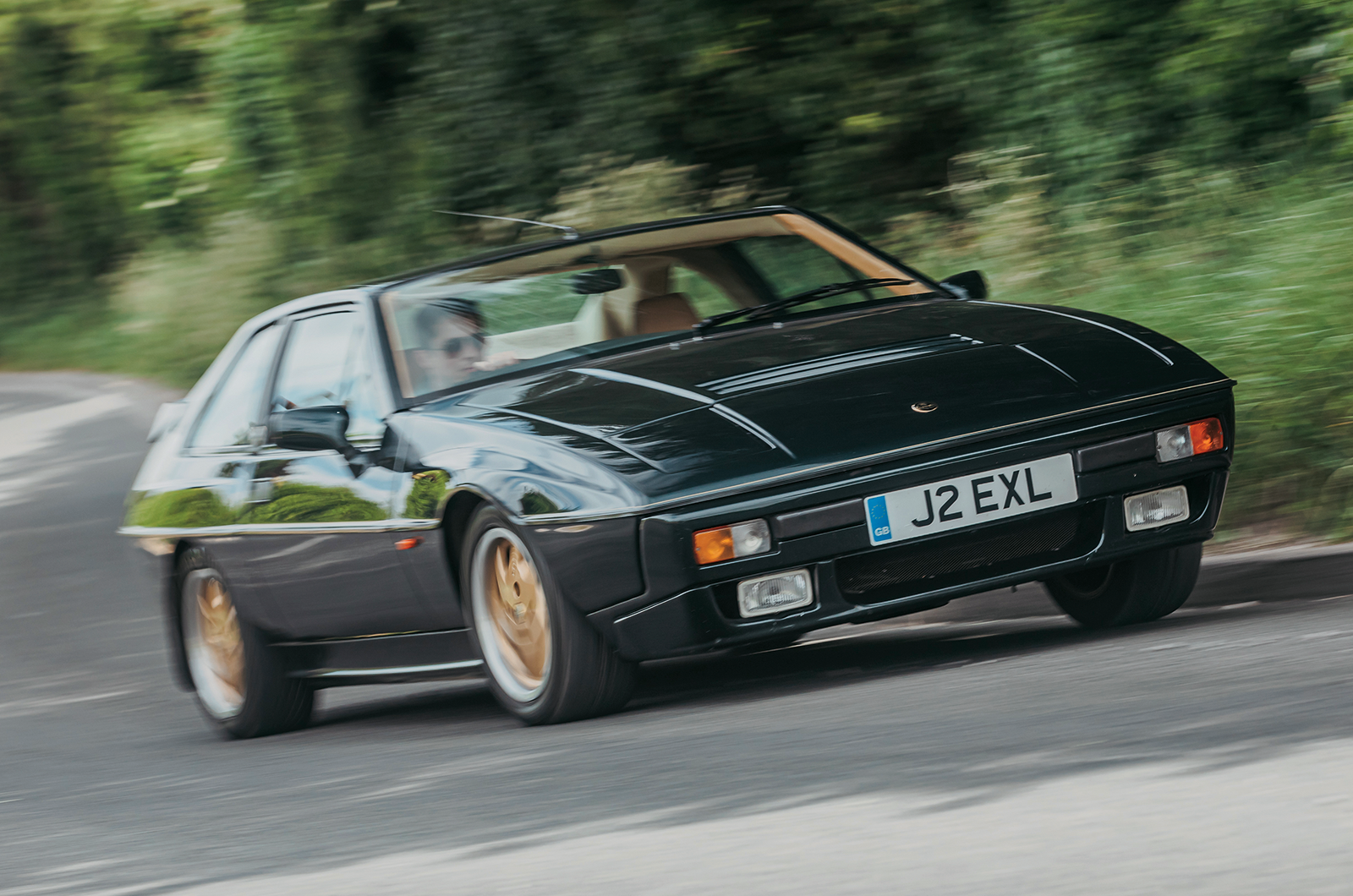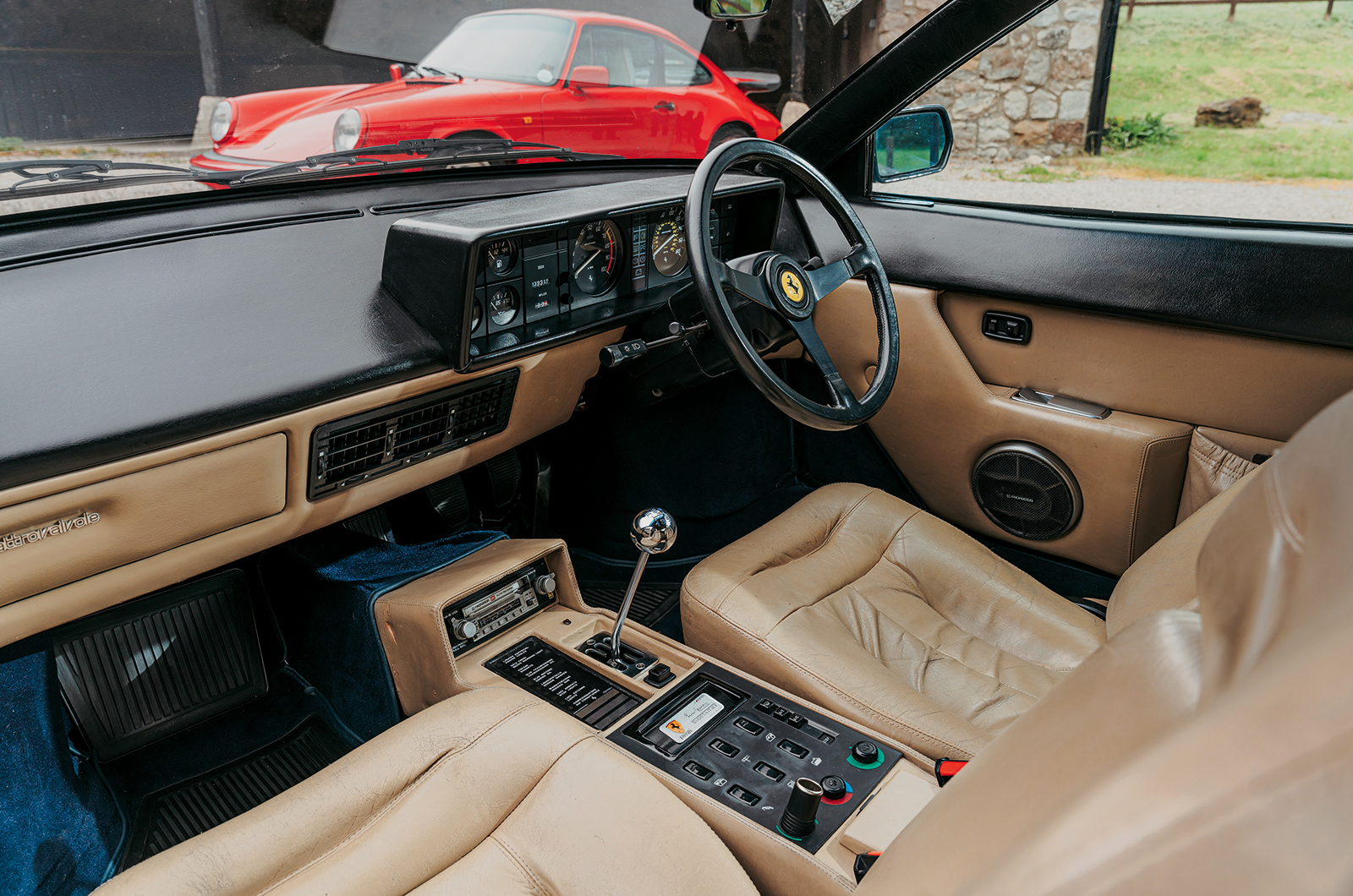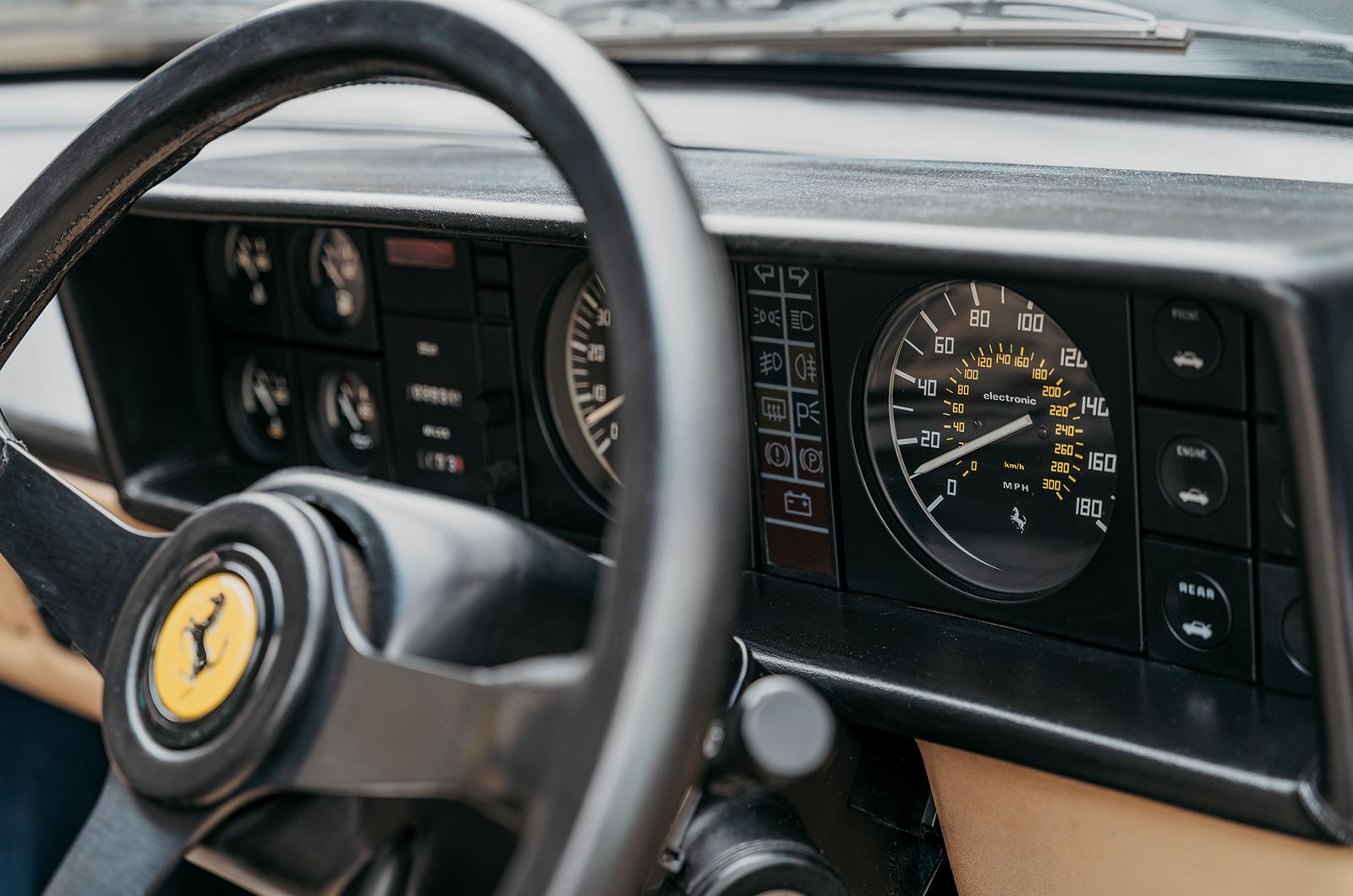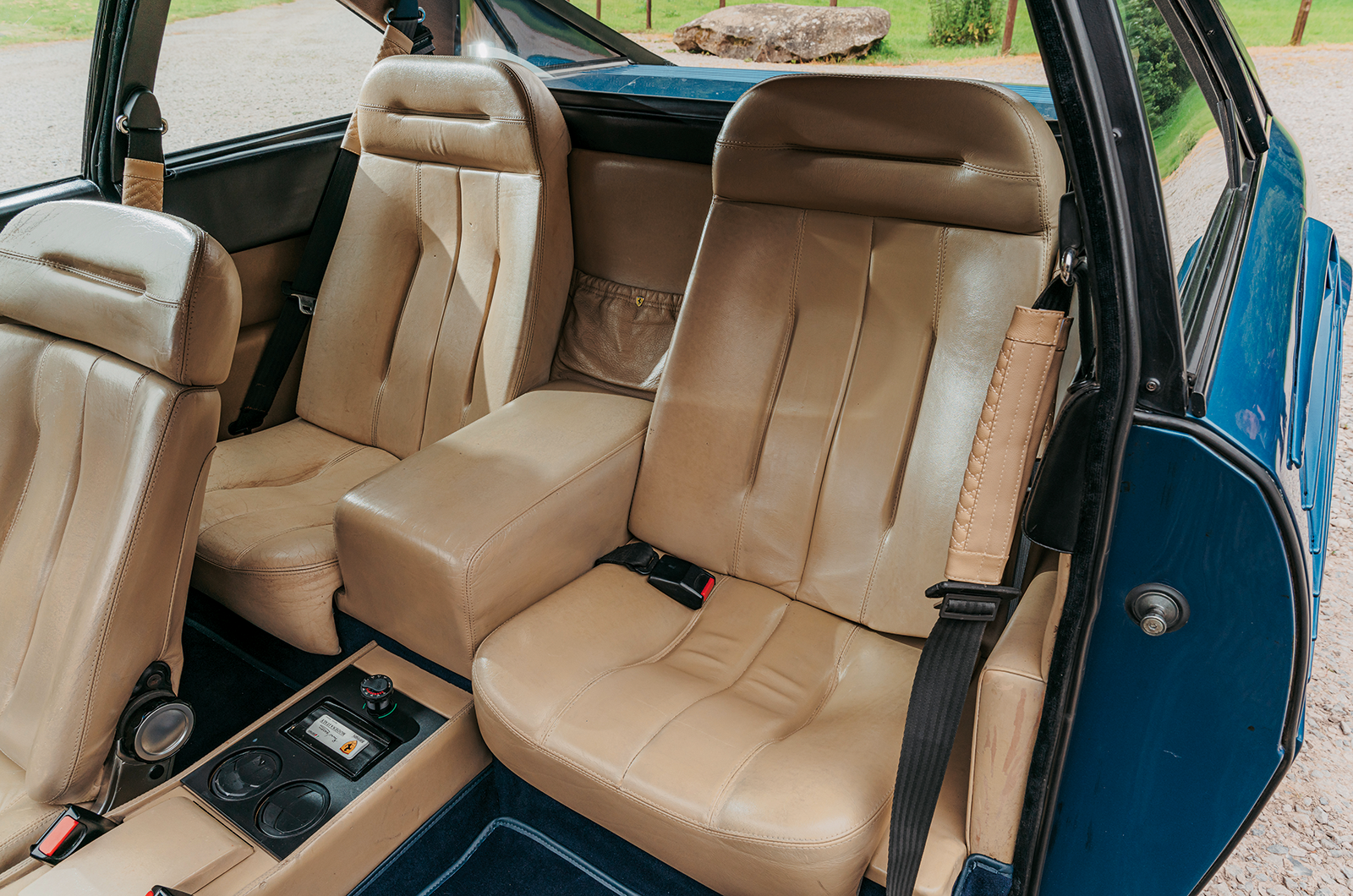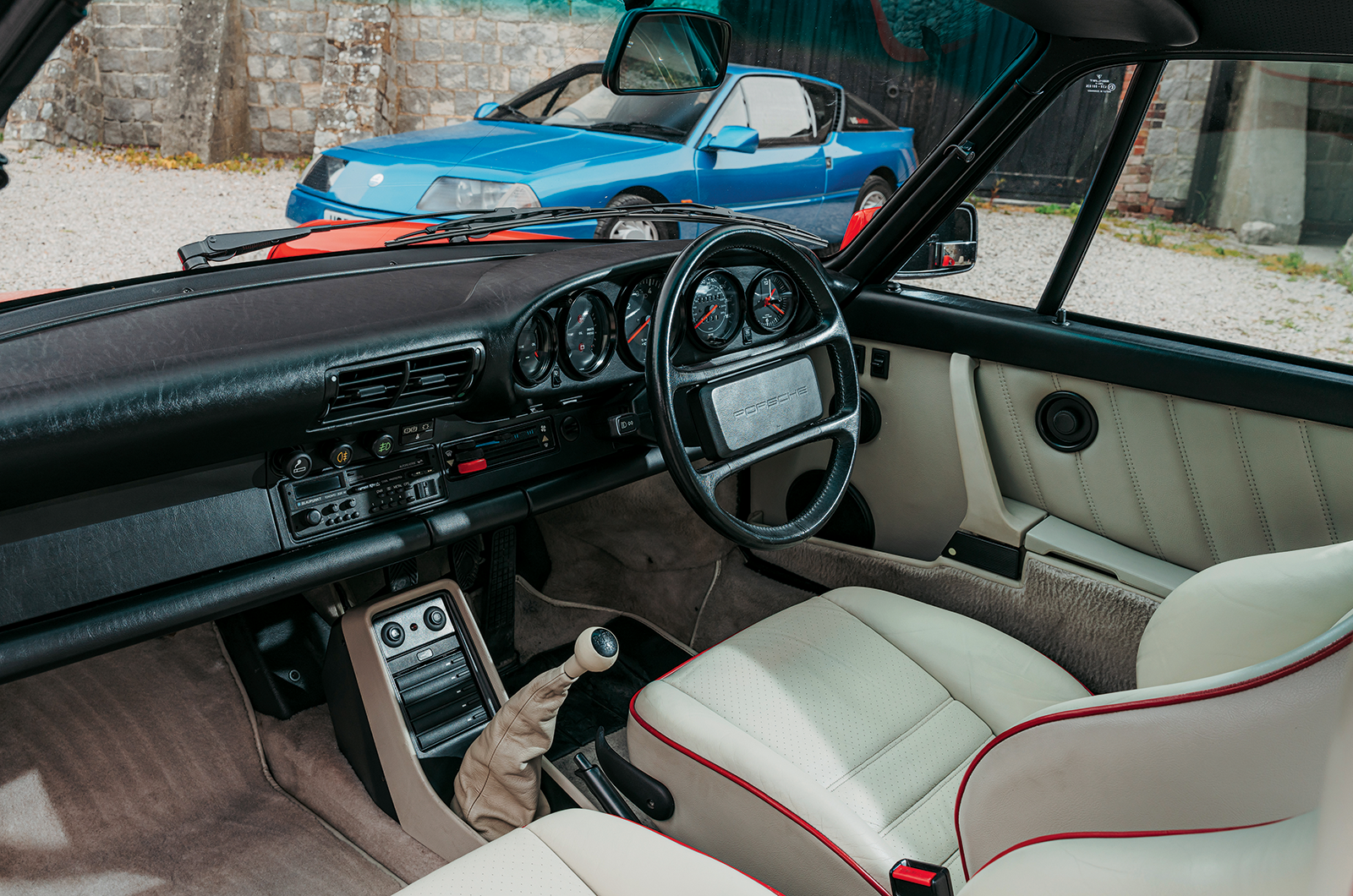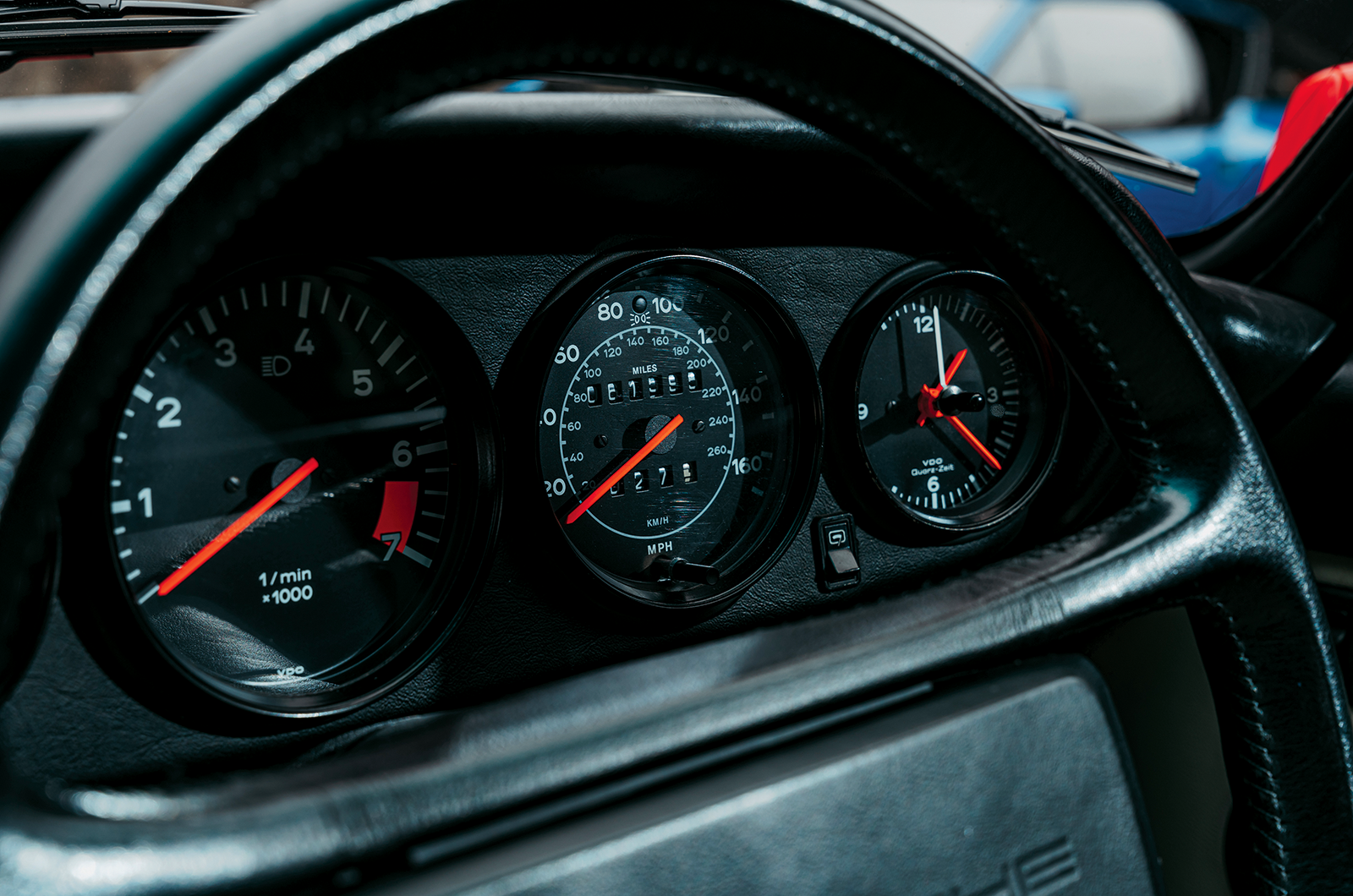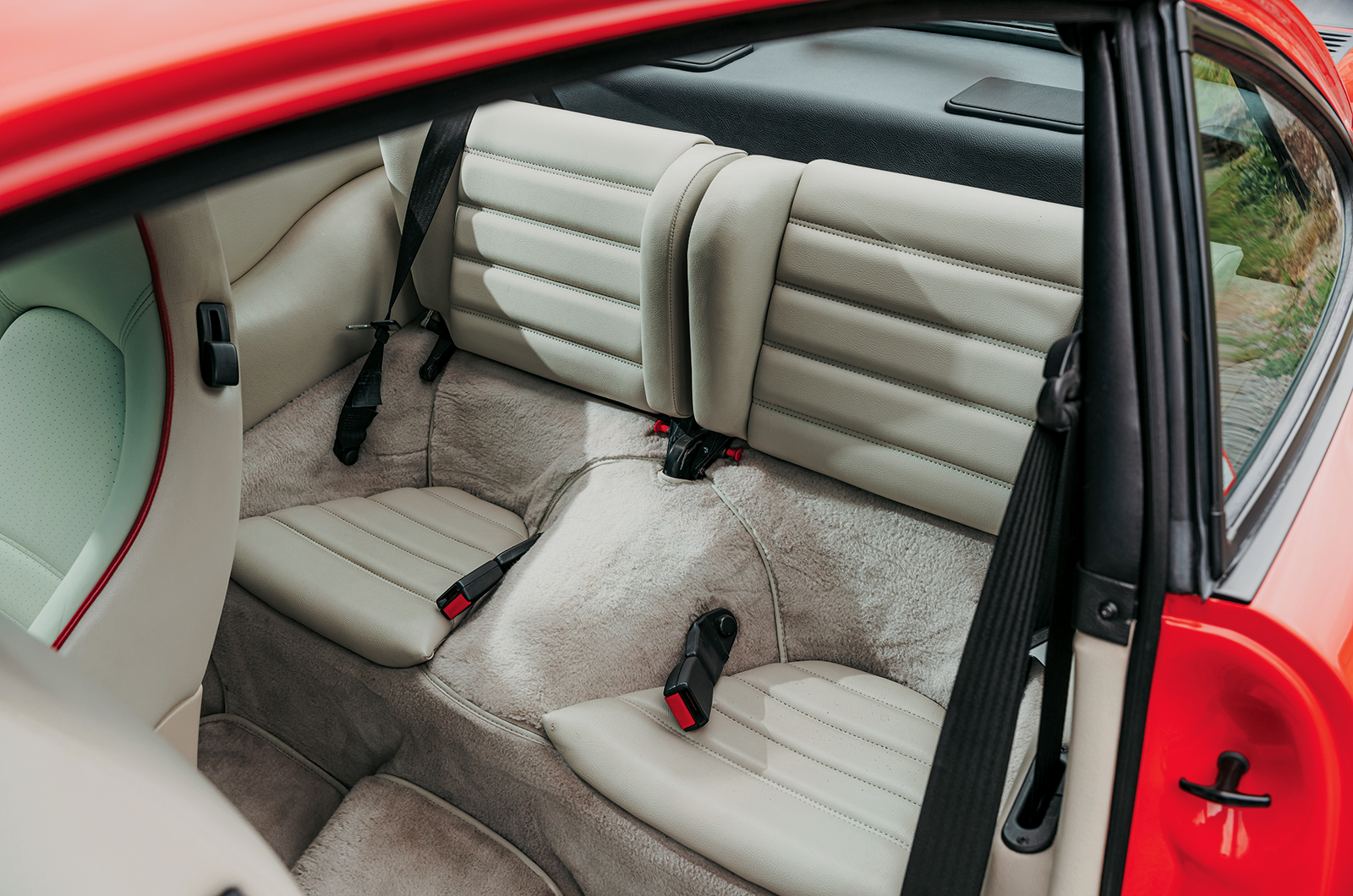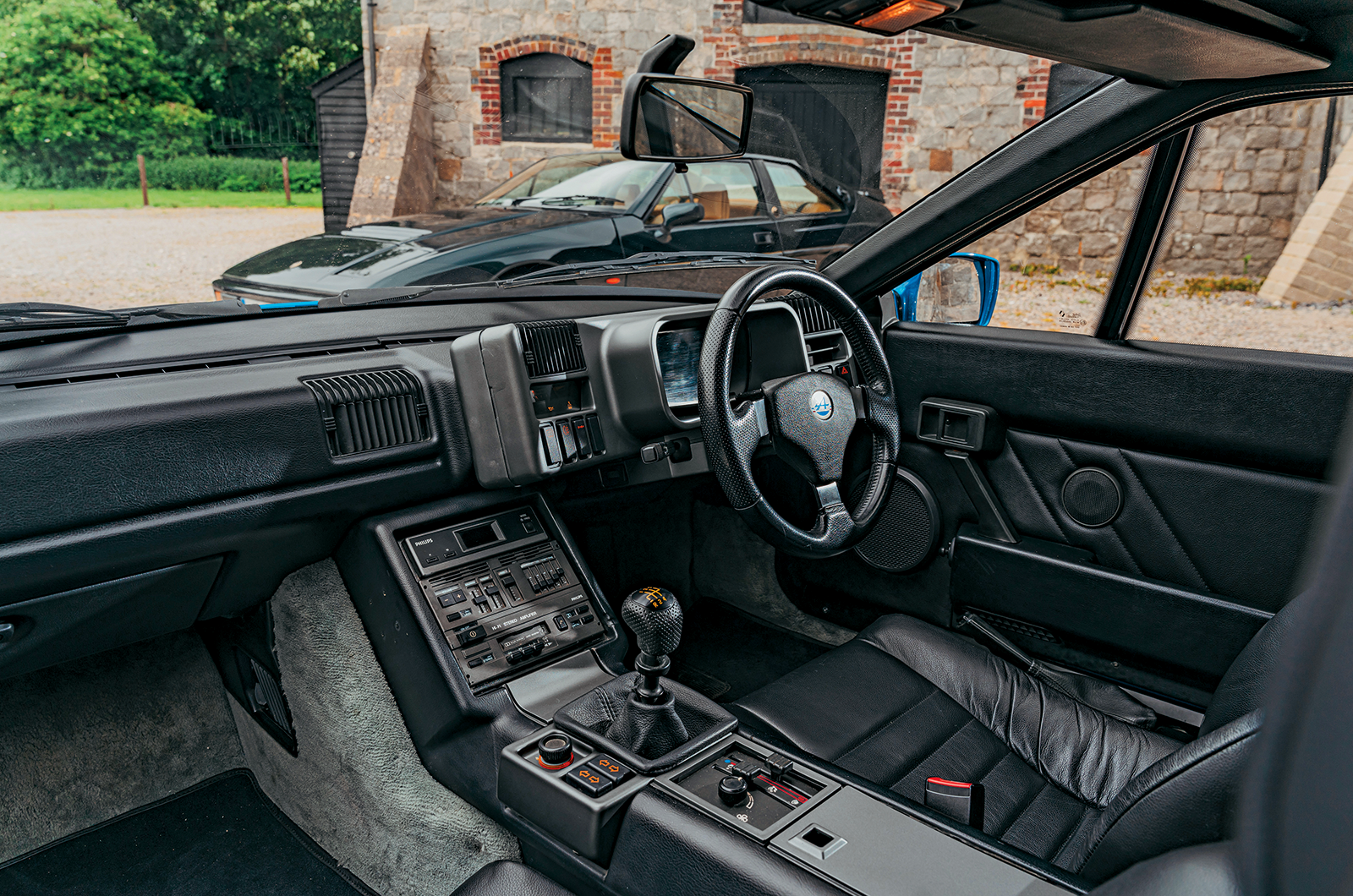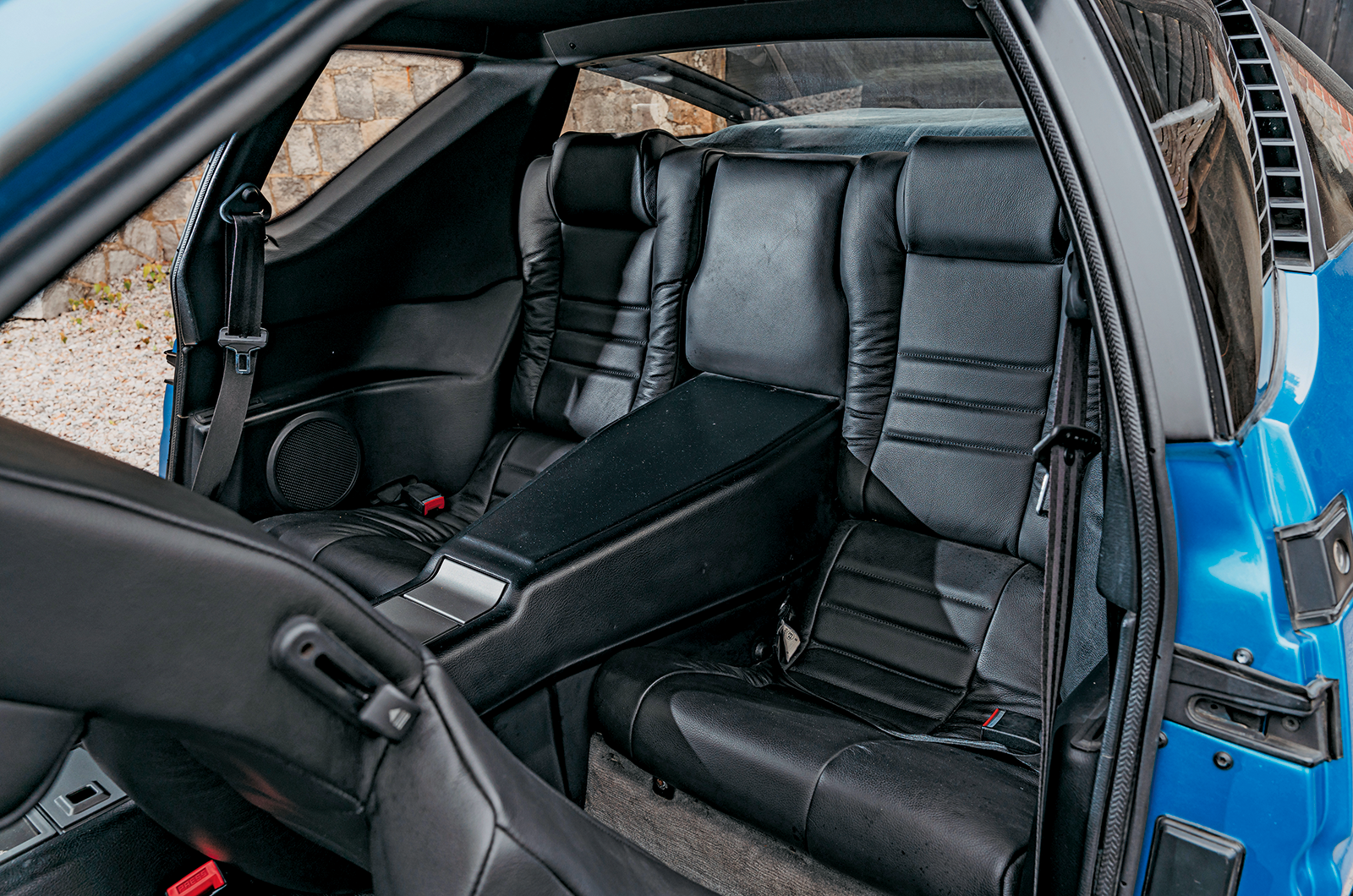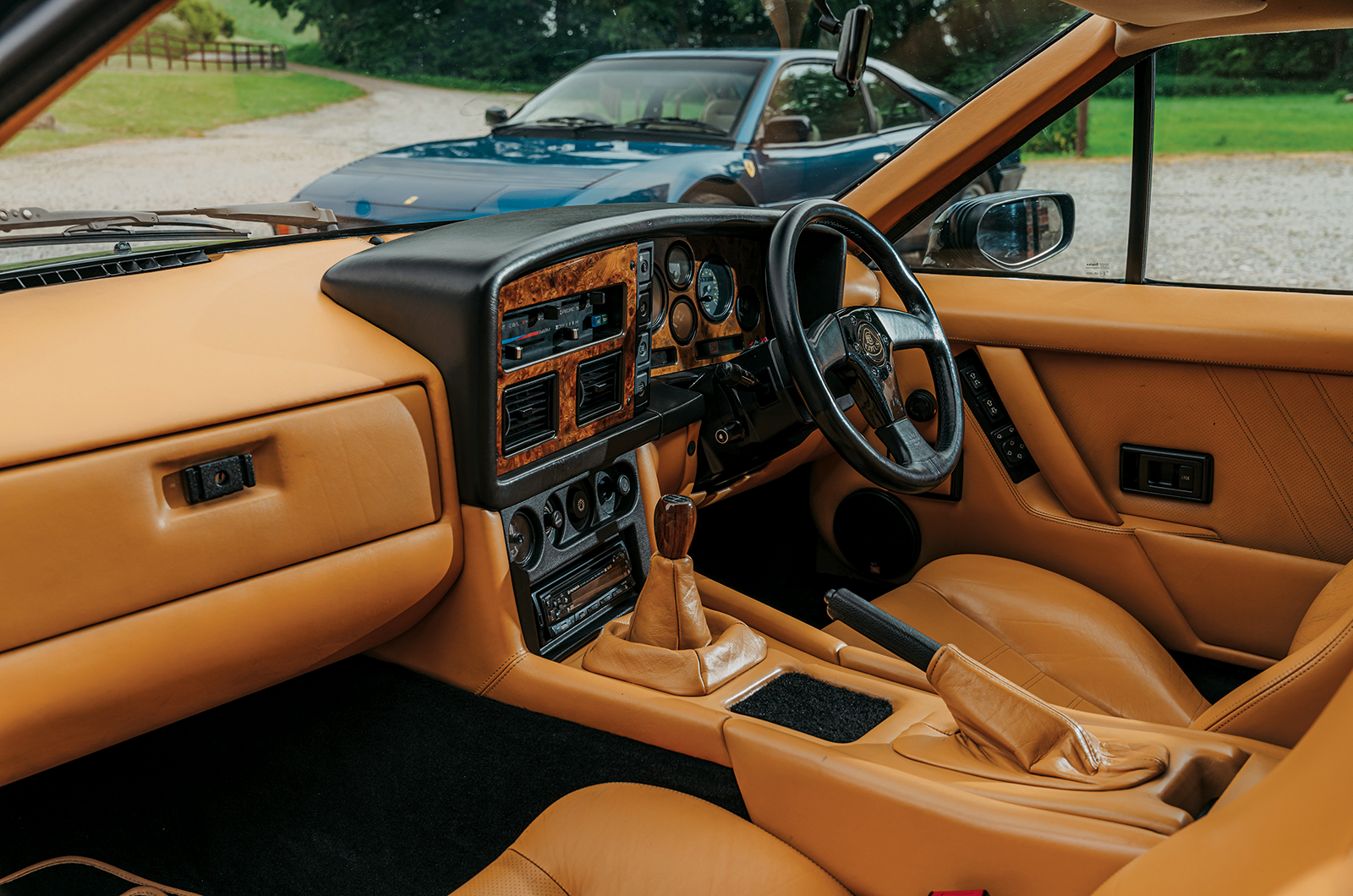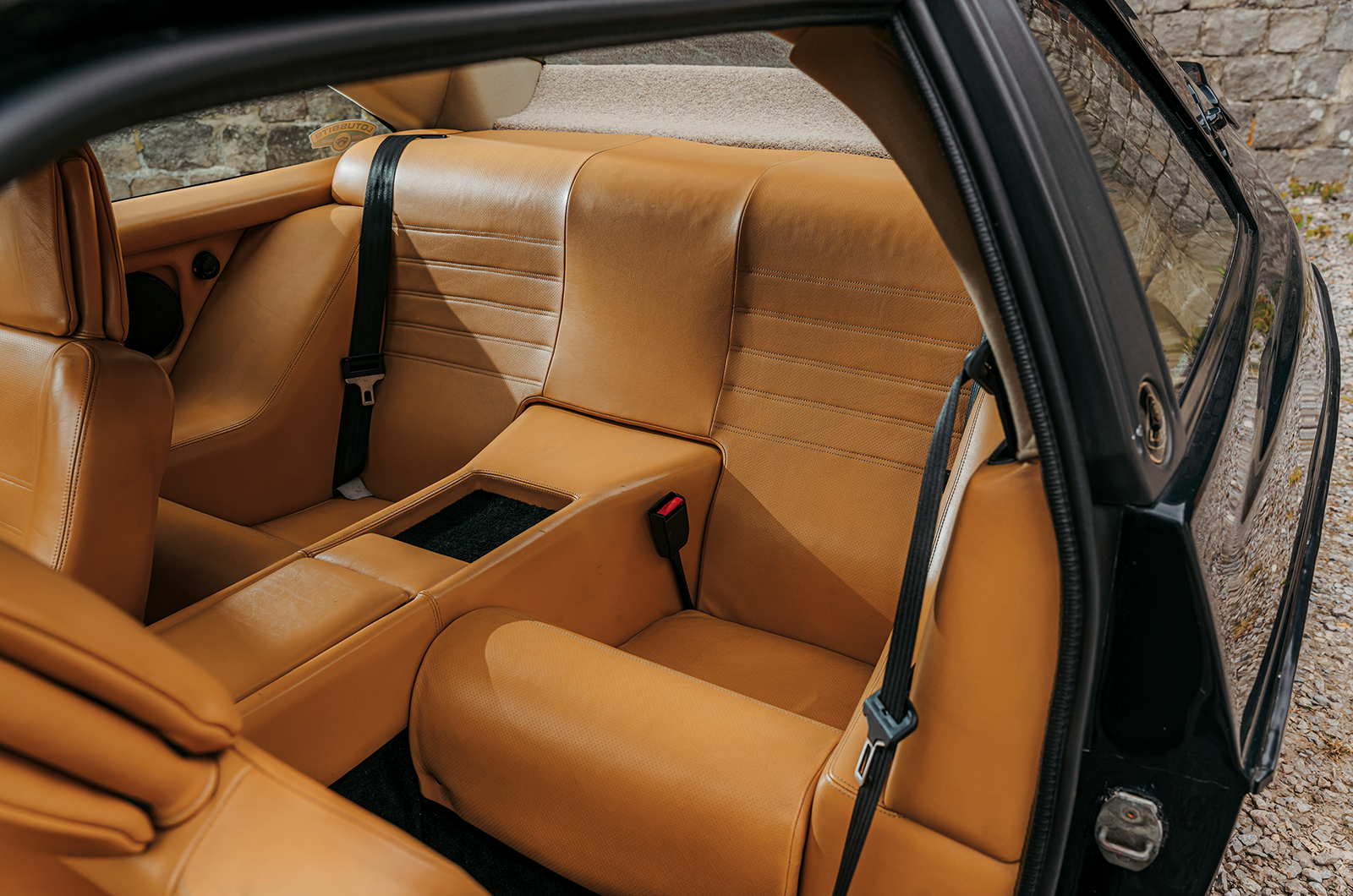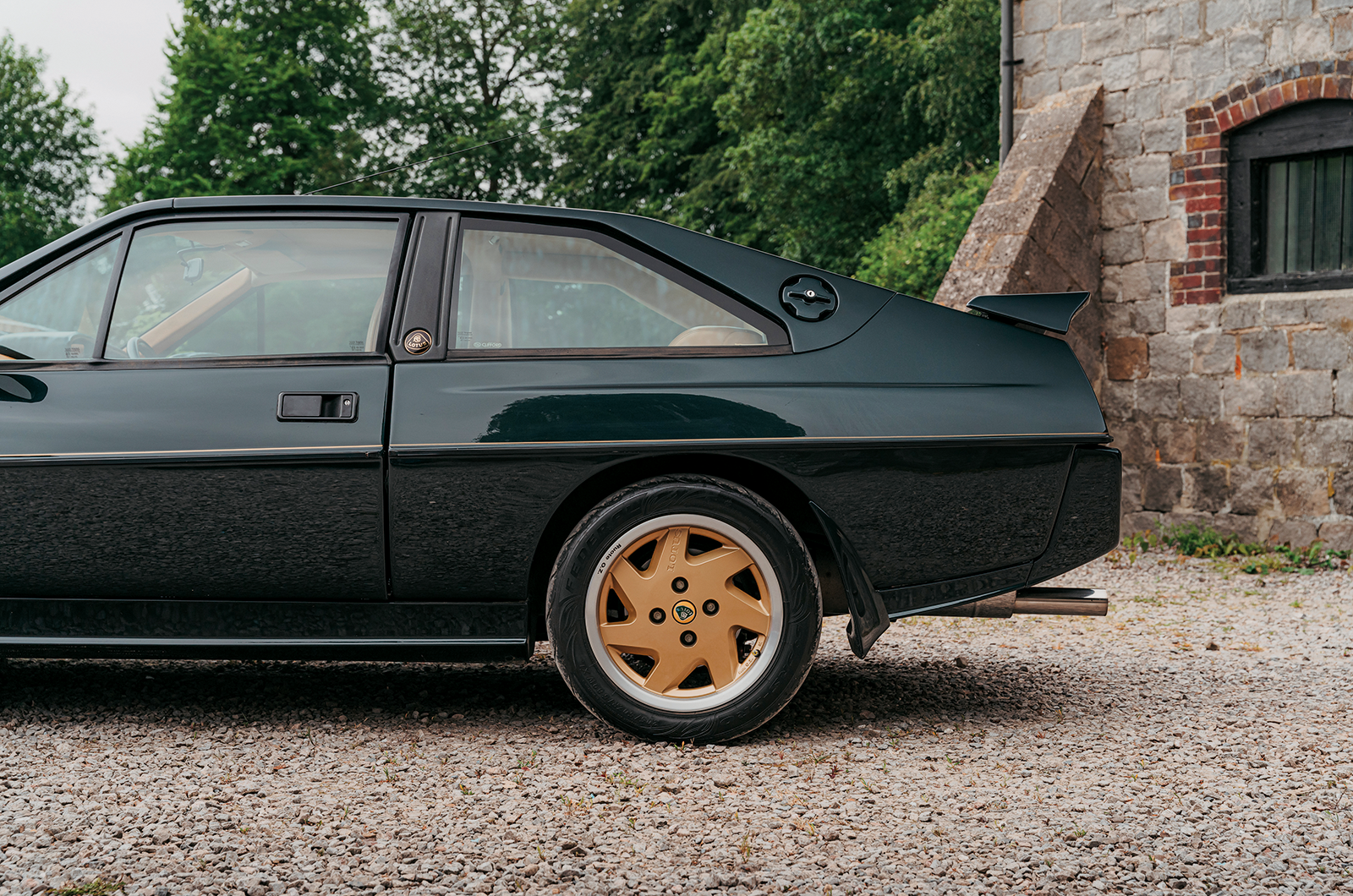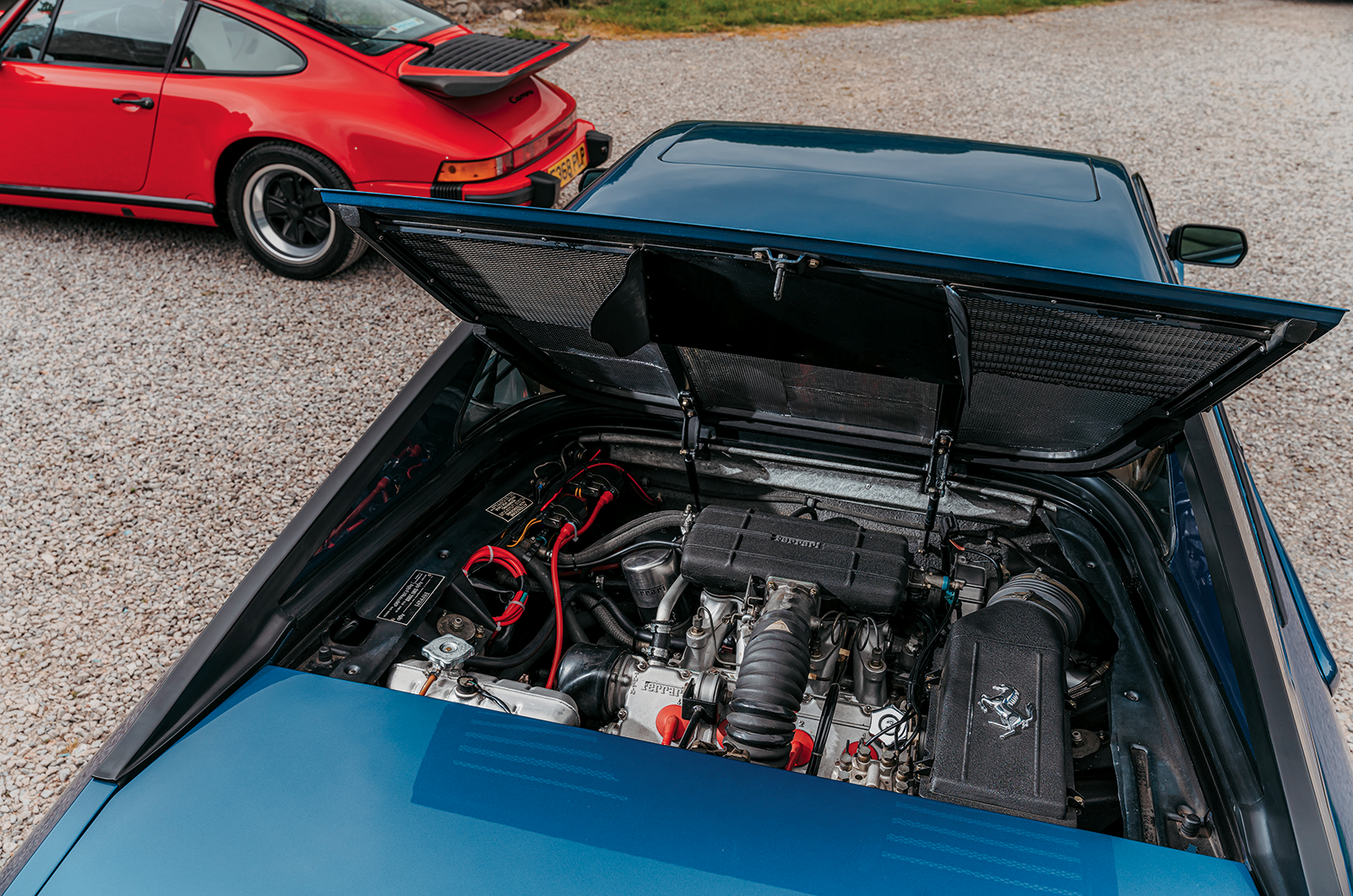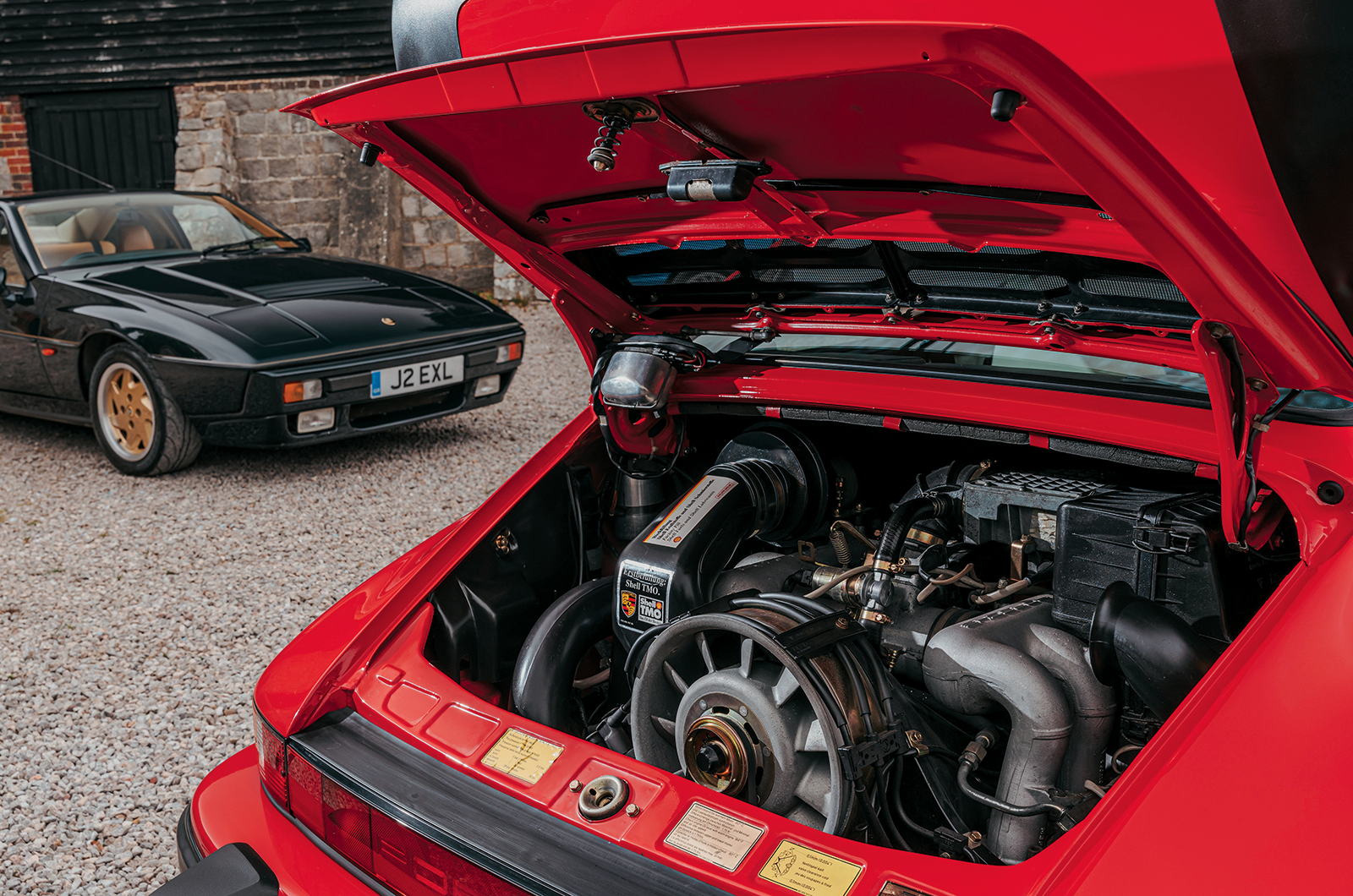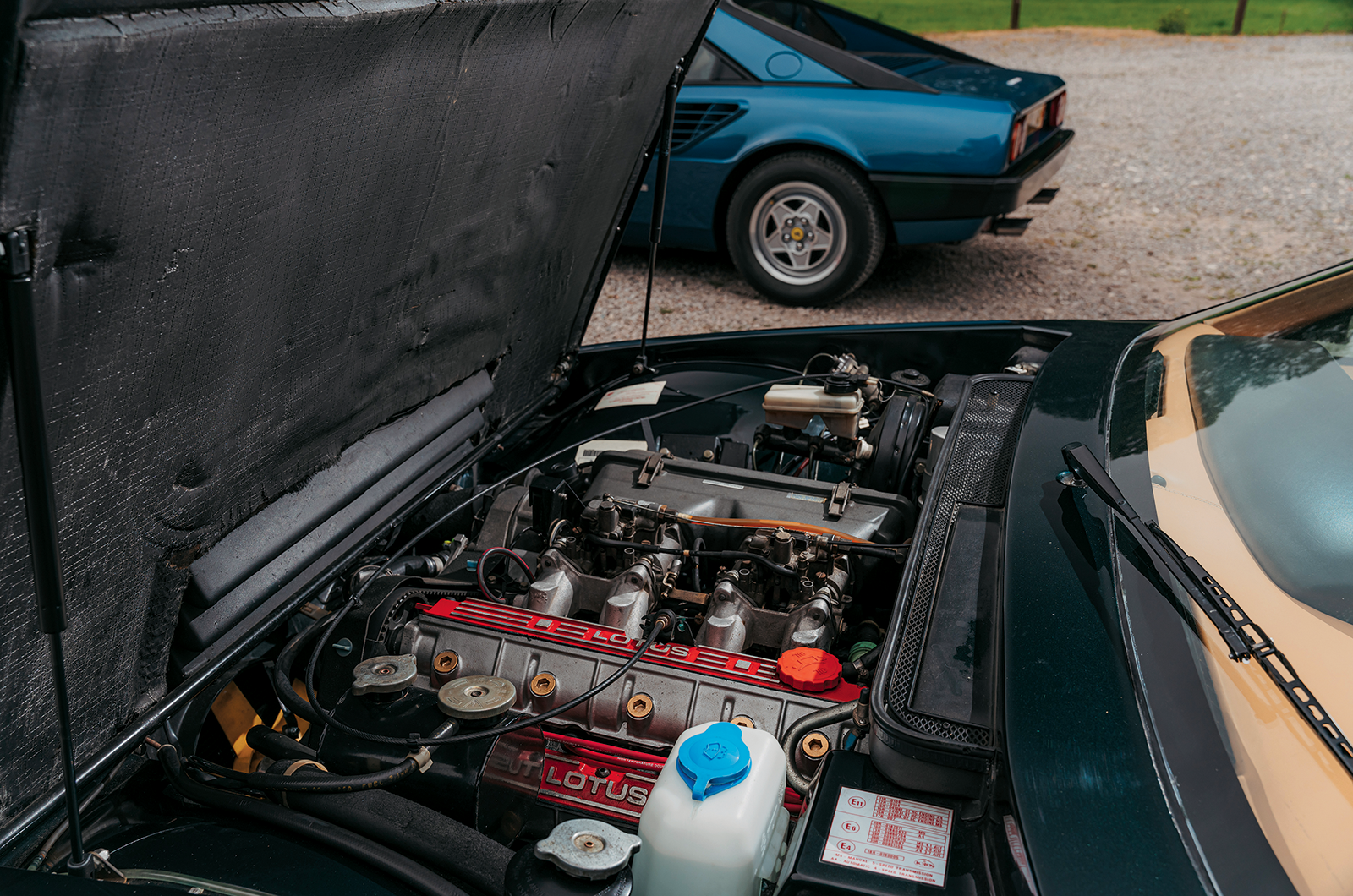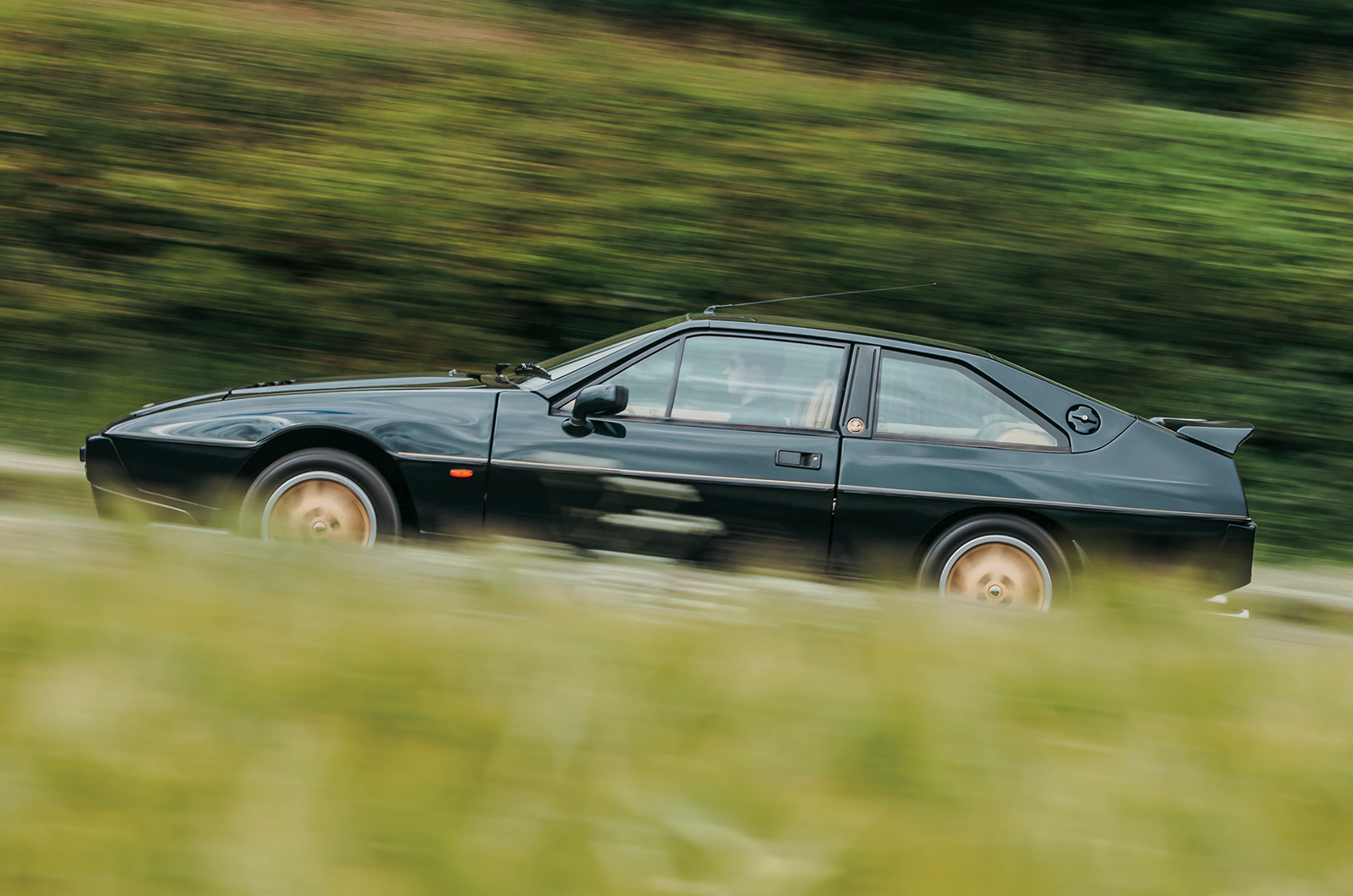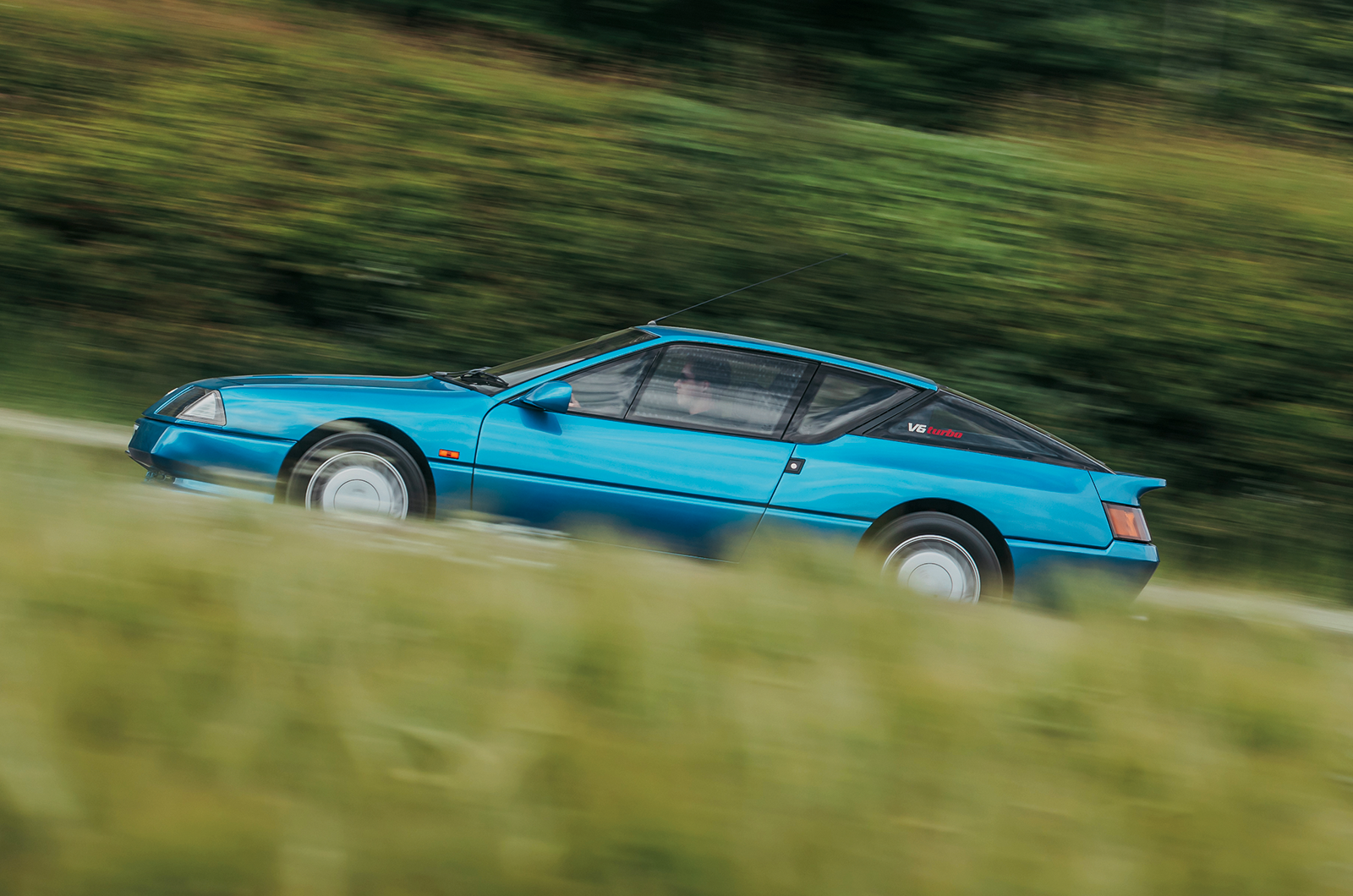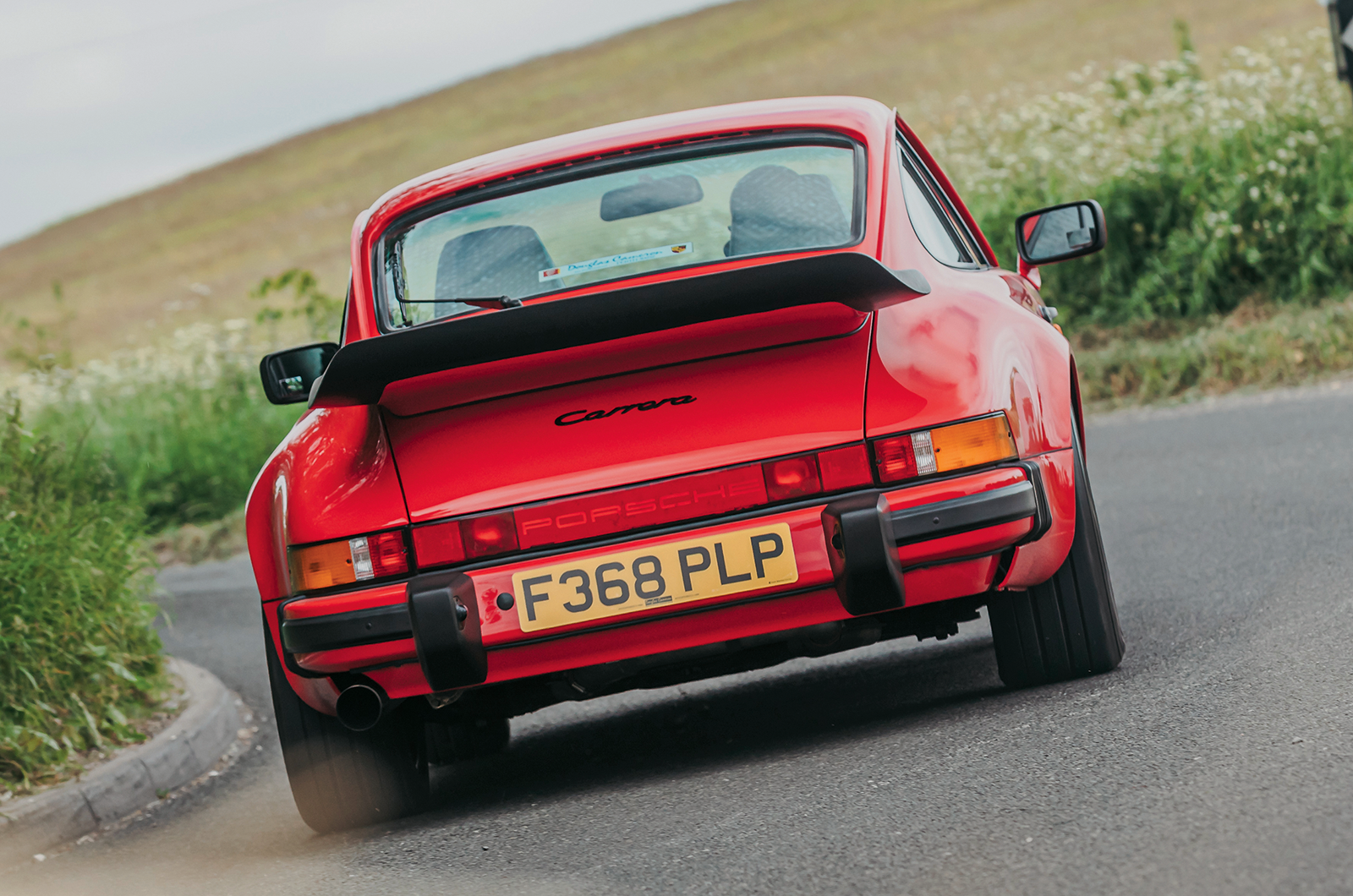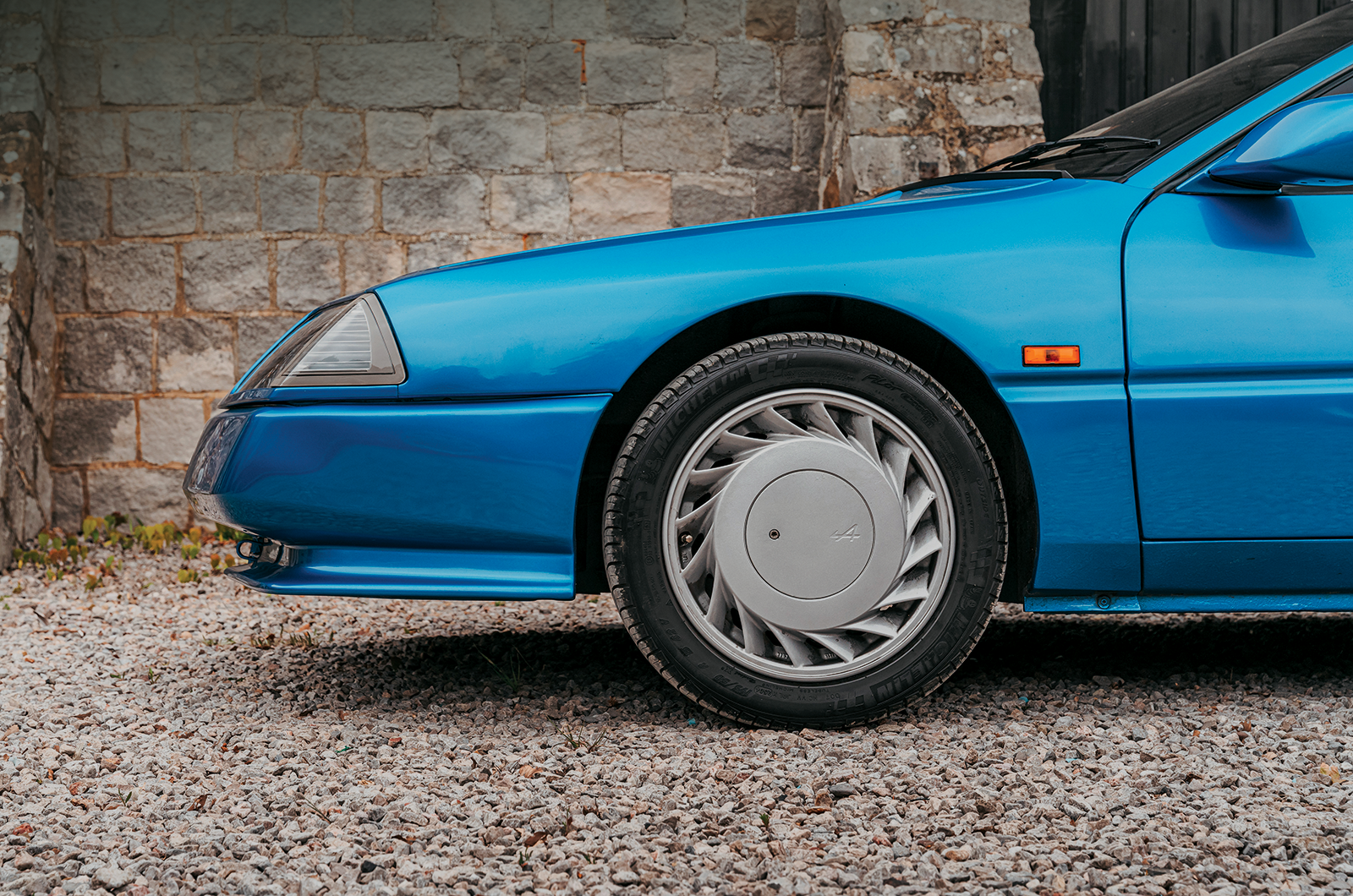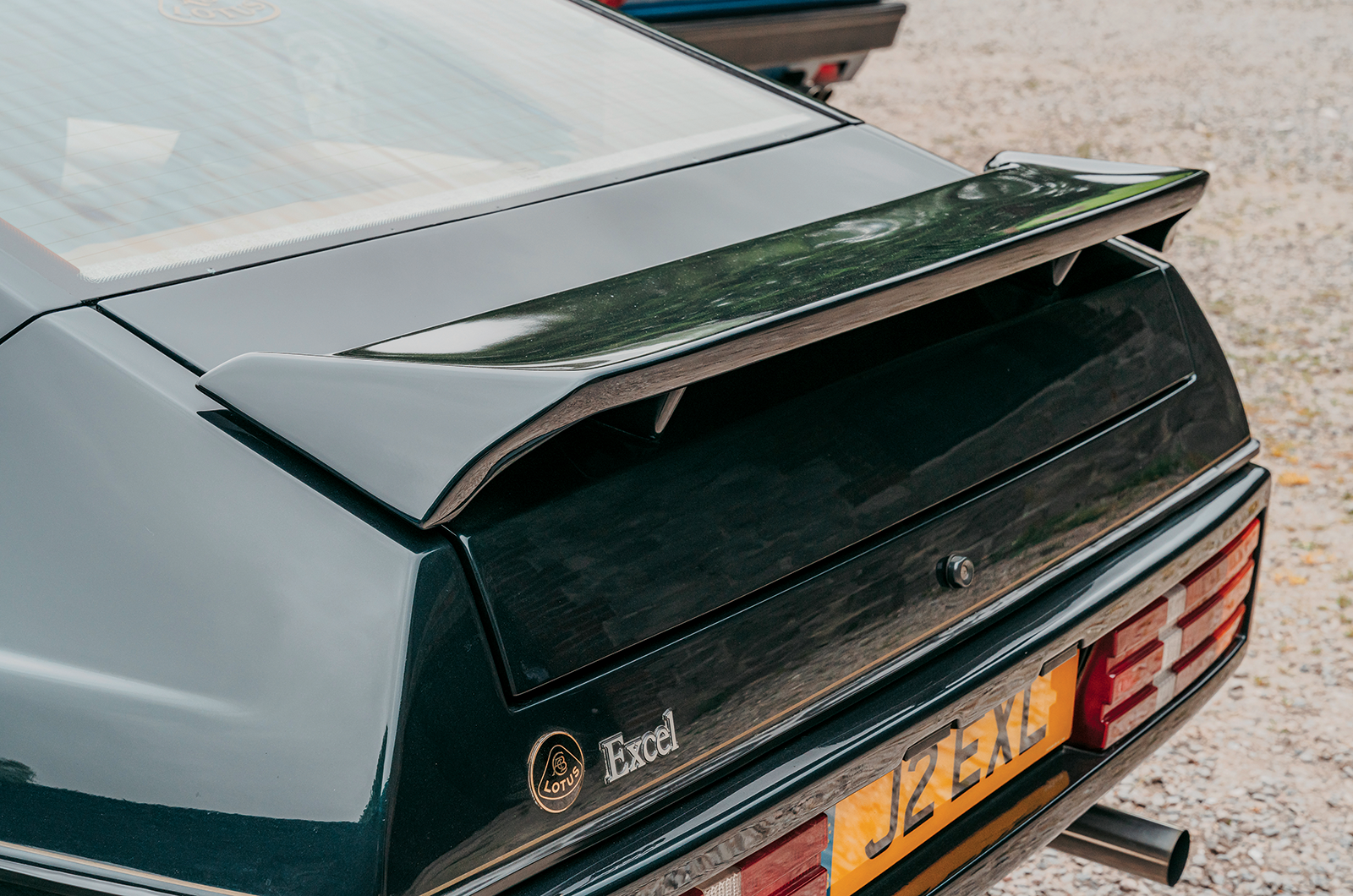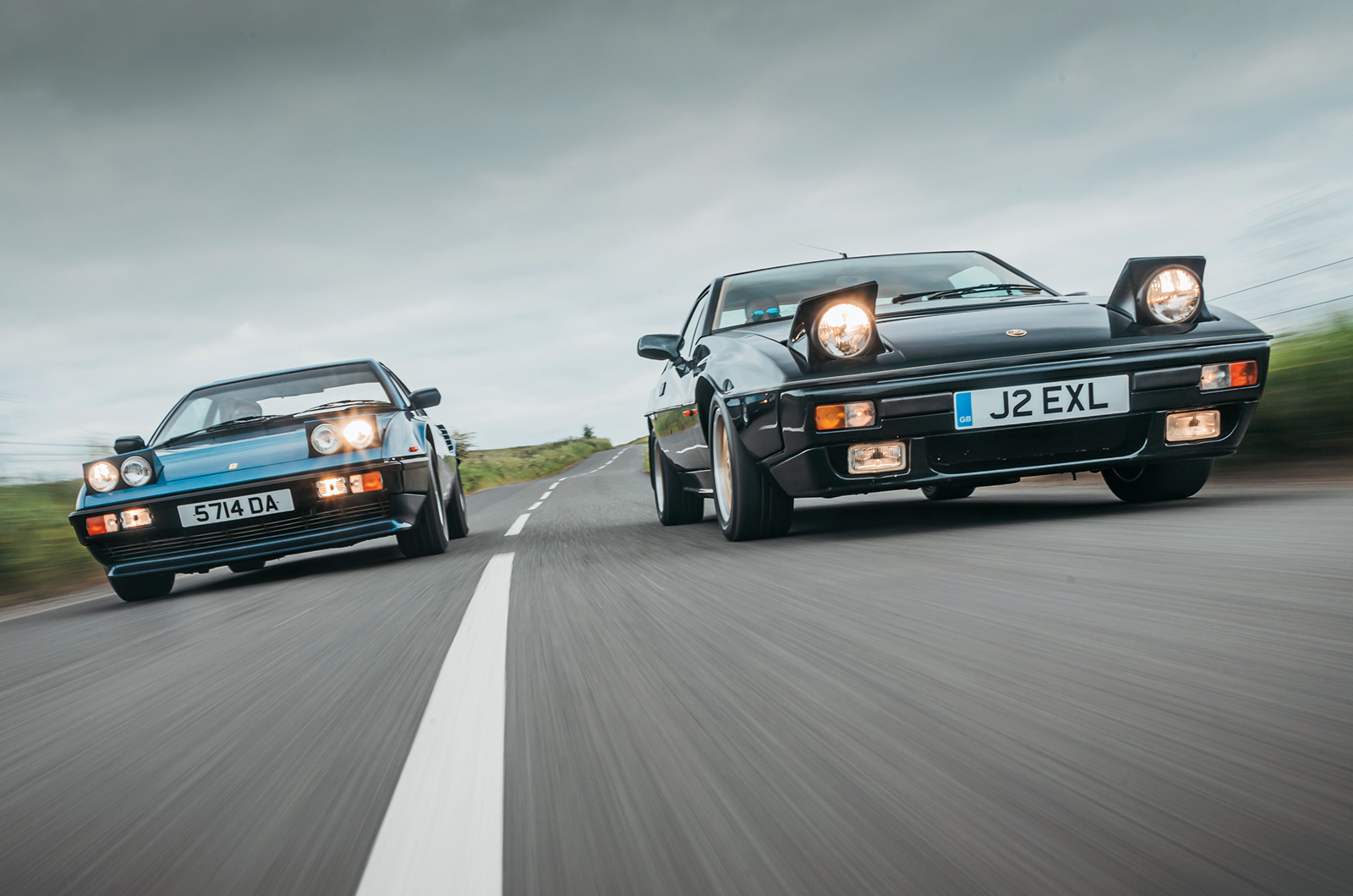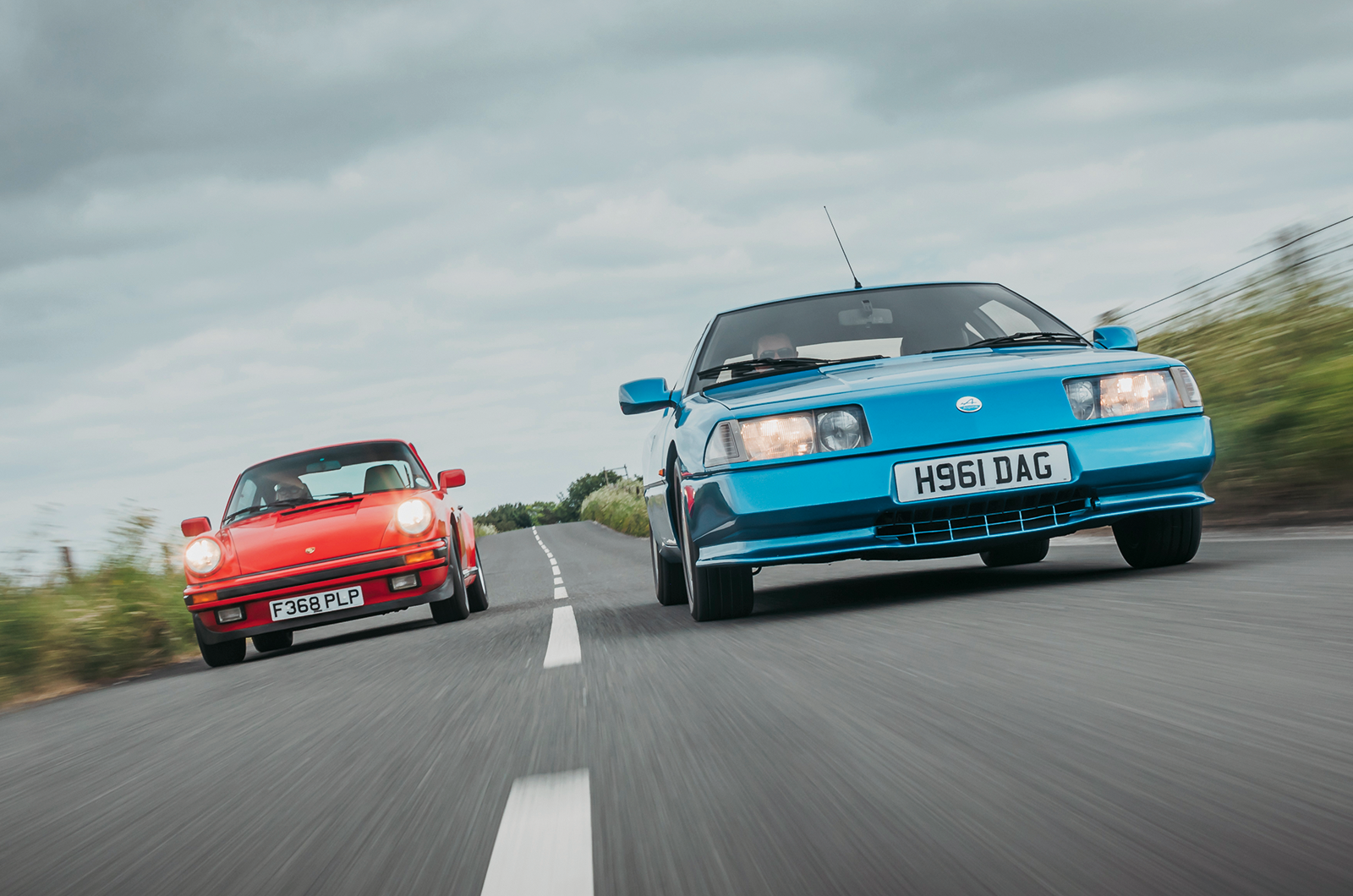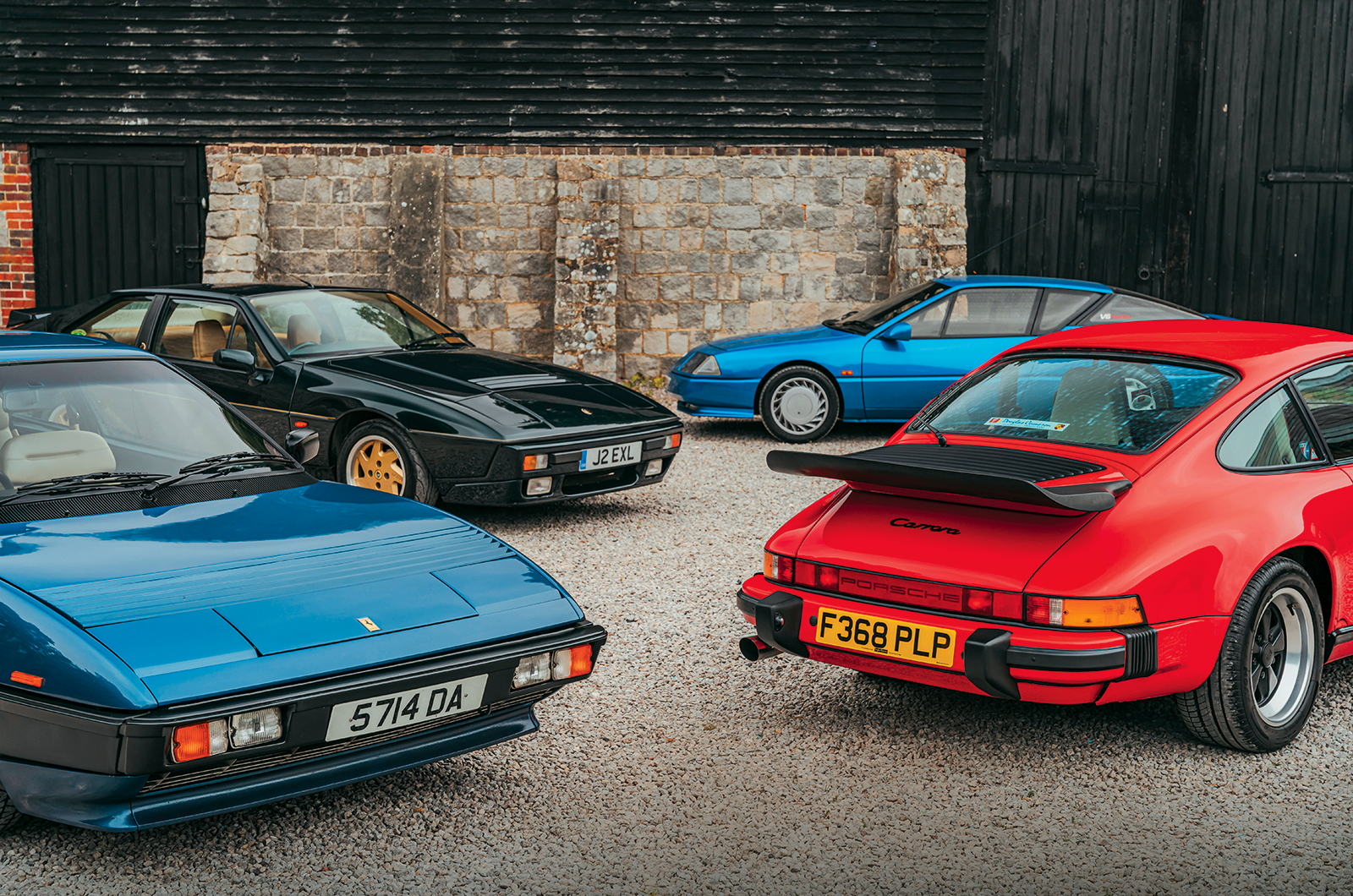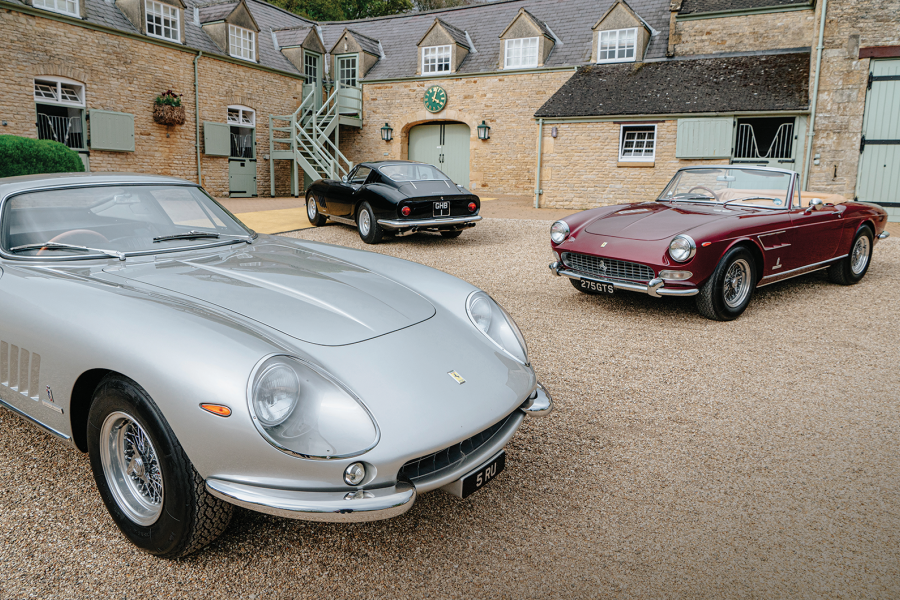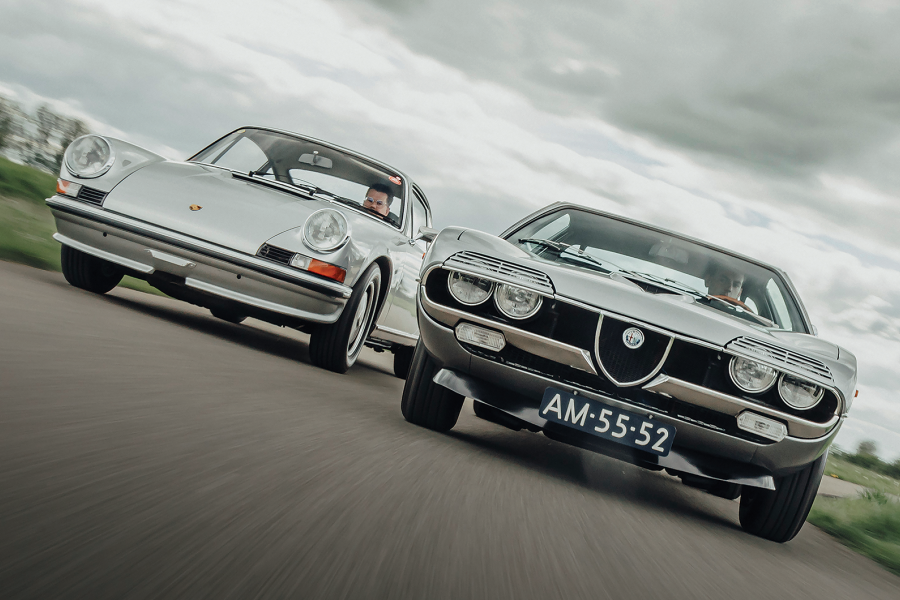Underneath the GTA’s refined and spacious cabin is a lightly updated A310 chassis; so, too, is its glassfibre body glued together and mated with the steel structure like past Alpines, and the venerable PRV V6 was also carried over.
But Renault pored over this car with a genuine ambition to take the fight to Porsche and anyone else who might get in the way.
At the height of its powers of race-winning, and with a long-built reputation for engineering, this avant-garde flagship held real significance alongside its businesslike sibling, the Renault 25 Turbo.
The large engine lid gives good access to the Ferrari’s 32-valve V8, which revs to 7500rpm
Adding an intercooler and revising the exhaust, ignition and ‘Remix’ injection systems gave the GTA an 18bhp and 3lb ft edge on the executive hatch, while double-wishbone suspension all round, with anti-dive geometry, turbo-specific dampers and fat 225/50 tyres at the rear, with 195/50s at the front, completed a compelling junior supercar package.
The engine had been moved forward 1.6in from the A310, improving weight distribution by around 3% to 38.1 front, 61.9 rear, while the dramatic lines courtesy of R5 Turbo designer Yves Legal were remarkably clean through the air.
The standard GTA had a drag coefficient of 0.28, rising to 0.30 for the intake-hungry turbo – which left the 0.39Cd Porsche lagging behind in the high-speed stakes.
The Porsche 911’s revised flat-six included new tensioners, and there is a gearbox-oil cooler
Although the Alpine’s rear seats are full-sized, neatly contoured and vastly more inviting than the Porsche’s finely trimmed shelves or the Excel’s oddly recessed squabs, the Ferrari Mondial’s glassy cabin is the only one here that delivers on the promise of a full 2+2 experience.
Its rear seats sit 2in above those in front, offering a welcome view of an interior perfectly in tune with the first-class airport lounge that Maranello had likely envisaged a quartet of impatient jet-setters travelling to in its rapid four-seater.
With an additional 100mm added to the 308GTB’s wheelbase, Pininfarina’s elongated fixed-head design can appear a little awkward in profile, but quickly captures the eye with its fine Ferrari detailing.
The Renault Alpine’s ubiquitous PRV Douvrin V6 engine makes 200bhp, but has the most torque here
Straked vents, the inverted-dish five-spoke alloys and the way the richly finished bodywork tucks underneath hints at engineering in another class to the others.
Its flat-plane-crank V8, equipped with Bosch K-Jetronic fuel injection and run by Digiplex electronic ignition, was reworked into the 32-valve quattrovalvole in 1982, upping power by 26bhp to 237bhp, but even its final, 300bhp iteration failed to quite match the old Dino 308GT4’s power-to-weight ratio.
It is also the largest and heaviest in our group.
The Lotus Excel SE’s twin-cam ‘four’ got Mahle forged-aluminium pistons and liners
But this was a Ferrari that appealed to mass audiences not just on price, size and pace: it was far more refined, less of a headache to own and eased drivers into the zeal of the marque without the intimidation of a traditional supercar.
“I like a little bit of luxury with performance,” says owner Louis Chavasse, who is also a fan of modern-classic Maseratis, “I’m just mad about Italian engineering.”
During a body and trim restoration of his 1984 QV, he added some extra soundproofing.
‘The Ferrari [left] rewards in full colour but without the sharp edges of a full-blown supercar, yet the Lotus is even easier to exploit’
On a comfortable, Modernist showpiece of a seat mounted mere inches from the floor, vision out of the bright cabin is excellent and the muffled firing of eight exotic pistons behind you sustains the odd sensation of a supercar and supersaloon combined.
A blip of the throttle elicits a softer-edged bark from the V8 than in a 308GTB, while the steering feels almost dull in its low-speed lightness.
The skewed driving position remains, though, as does the galloping drama of a Ferrari on song when you open the taps: what begins as a car that feels bereft of torque compared with the Porsche and Alpine spins up into a frenzy of cammy revs and a thrashing flat-plane roar that won’t fail to impress passengers with its sense of urgency, even if it ultimately remains off the pace of the others.
The glassfibre-bodied Renault Alpine GTA (left) is lighter than the Porsche 911 overall, but more rear-biased
At full tilt, the steering comes mostly back to life on its calmed geometry, pairing well with a benign balance and supple suspension that rewards the driver in full colour but without the sharp edges of a full-blown supercar near the limit.
The Lotus Excel may be even easier to fully exploit, which, being the least powerful here, is particularly useful.
Its direct steering dials you into a chassis that claws grip out of every ripple and twist of the Tarmac beneath, as long-travel coil springs blend even the most challenging roads into consistent responses.
The venerable Lotus twin-cam is a willing partner in an all-out attack of a typical British B-road, charging in full-bore anger through twin Dell’Orto carburettors.
The Ferrari’s straked vents are eye-catching
In high-output SE spec, it has a raw enthusiasm born out of increased, 10.9:1 compression, more aggressive camshafts, and freer-breathing inlet and exhaust ports.
The Éclat Excel had arrived in 1982, and was such a significant revision to the then eight-year-old Éclat that it soon became simply Excel.
Changes to the classic backbone chassis, rear suspension and a sleek new glassfibre body with a 0.32Cd joined a variety of Toyota-sourced driveline and detail components that were all aimed at providing greater reliability, build quality and refinement for a model that was already acknowledged as a talented driver’s car.
The Porsche 911’s whale-tail spoiler is not for shy types
Following the 180bhp SE in 1986, the 1991 Celebration trim aspired to even greater, more refined heights.
Ostensibly to mark 25 years of the Hethel factory, it was also a cunning way to maximise the Excel’s appeal as it approached the end of production, featuring glossy ‘Marque Lotus Metallic’ paint with gold detailing and tan leather trim, along with standard air conditioning and wool carpeting.
But against the expansive packaging of the Mondial and the inherent interior space advantages of the rear-engined duo, the Excel’s cabin feels cramped and old-fashioned.
The Renault Alpine GTA V6 Turbo’s subtle turbine alloy wheels
Rolls of leather-trimmed hardpoints encroach on the footwells, fouling the driver’s knees, while rear passengers are expected to adopt postures really only appropriate for gymnasia.
The way engine heat seeps in through the bulkhead and the Dell’Ortos grumble around town ultimately reveals this car’s roots as one of the great-driving yet still compromised classic British sports cars, rather than a sophisticated high-performance machine of the modern era.
And yet, even beyond the heat-soaked whiff of ancient BL plastics and unconvincing burr-elm trim, there is something oddly glamorous about the Excel Celebration that feels perfectly fitting for the last front-engined Lotus sports GT.
The Lotus Excel SE has a decent drag coefficient of 0.32Cd
“Now I’ve had a Lotus, I don’t know what else I’d have,” reflects owner Rob Mepsted on this Norfolk magic.
“Even for an Esprit, I don’t know if I could get rid of this first.”
Indeed, for the money, little else comes close.
It looks and plays the part with a shape as lithe as its handling, a proper gem of an engine and refinement levels enough for long tours.
If it didn’t quite capture the imaginations of uncompromising yuppies at the time, its Lotus-branded charm might now resonate stronger than ever – especially for those who have tried to get in and out of an Esprit.
Pop-ups root the Mondial and Excel firmly in the ’80s, but the Lotus shape dates from 1975
Unfortunately, it is in the company of cars with just as much dynamic flair but better manners and more generous interiors.
The Alpine is in danger of being too polite, so determined is it to turn a supercar into an executive express.
Contrary to the bold red lettering on the outside, you sometimes wonder where the ‘V6 turbo’ has gone.
Apart from a protest of cams at high revs, and the subtle whirr of forced induction, the main drama the GTA delivers is in its continent-crushing pace.
And yet this primary failing as a supercar could equally be seen as part of its character as an avant-garde performance weapon. Its wild design certainly still delivers.
‘The anticipation of piloting one of the best ’80s driver’s cars is just as gripping as it must have been for a lucky go-getter back in the day’
The Porsche is as good as it’s ever been, and probably still the envy of many rising stars.
To be dropped off at school in one could even be worth the discomfort of its rear ‘seats’, and the legendary G-body 911 has the sort of robust staying power that lends itself to inheritance.
But if your eyes are wide open to having it all, the Ferrari Mondial has the drama, details and practicalities to more than fill your appetite.
If you have the (actually rather modest) means, I highly recommend picking one up.
Images: Max Edleston
Thanks to: Wiltshire venue Wick Bottom Barn; Lotusbits; John Law Engineering
Factfiles
Ferrari Mondial QV
- Sold/number built 1982-’85/1774 (all)
- Construction steel spaceframe chassis, steel body
- Engine all-alloy, dohc-per-bank, 32-valve 2927cc V8, fuel injection
- Max power 237bhp @ 7000rpm
- Max torque 192lb ft @ 5000rpm
- Transmission five-speed manual, RWD
- Suspension independent, by wishbones, coil springs, telescopic dampers, anti-roll bar f/r
- Steering rack and pinion
- Brakes discs, with servo
- Length 15ft ¼in (4580mm)
- Width 5ft 10⅓in (1790mm)
- Height 4ft 1¼in (1250mm)
- Wheelbase 8ft 8¼in (2650mm)
- Weight 3153lb (1430kg)
- Mpg 18
- 0-60mph 6.8 secs
- Top speed 144mph
- Price new £37,950
- Price now £30-50,000*
Porsche 911 Carrera 3.2
- Sold/number built 1984-’89/76,473
- Construction steel monocoque
- Engine all-alloy, sohc-per-bank, 12-valve 3164cc flat-six, Bosch Motronic fuel injection
- Max power 231bhp @ 5900rpm
- Max torque 209lb ft @ 4800rpm
- Transmission five-speed manual, RWD
- Suspension independent, at front by MacPherson struts, longitudinal torsion bars rear semi-trailing arms, transverse torsion bars; anti-roll bars f/r
- Steering rack and pinion
- Brakes discs, with servo
- Length 14ft ⅞in (4290mm)
- Width 5ft 5in (1652mm)
- Height 4ft 3⅞in (1320mm)
- Wheelbase 7ft 5½in (2272mm)
- Weight 2571lb (1166kg)
- Mpg 21
- 0-60mph 6.1 secs
- Top speed 152mph
- Price new £32,849 (Sport Equipment, 1987)
- Price now £50-70,000*
Renault Alpine GTA V6 Turbo
- Sold/number built 1984-’91/6942 (all)
- Construction steel spaceframe chassis, glassfibre body
- Engine all-alloy, sohc-per-bank, 12-valve 2458cc V6, Garrett T3 turbocharger, Remix fuel injection
- Max power 200bhp @ 5700rpm
- Max torque 210lb ft @ 2500rpm
- Transmission five-speed manual, RWD
- Suspension independent, by double wishbones, coil springs, telescopic dampers, anti-roll bar f/r
- Steering rack and pinion
- Brakes discs, with servo and ABS
- Length 14ft 2½in (4330mm)
- Width 5ft 9in (1754mm)
- Height 3ft 11⅛in (1197mm)
- Wheelbase 7ft 8in (2339mm)
- Weight 2601lb (1180kg)
- Mpg 21
- 0-60mph 6 secs
- Top speed 155mph
- Price new £23,635
- Price now £15-20,000*
Lotus Excel SE
- Sold/number built 1982-’92/2075 (all Excels)
- Construction steel backbone chassis, glassfibre body
- Engine all-alloy, dohc, 16-valve 2174cc ‘four’, twin Dell’Orto carbs
- Max power 180bhp @ 6500rpm
- Max torque 165lb ft @ 5000rpm
- Transmission five-speed manual, RWD
- Suspension independent, at front by double wishbones, anti-roll bar rear wishbones, transverse top links; coil springs, telescopic dampers f/r
- Steering variable-ratio power-assisted rack and pinion
- Brakes discs, with servo
- Length 14ft 5⅛in (4398mm)
- Width 5ft 11½in (1816mm)
- Height 3ft 11½in (1207mm)
- Wheelbase 8ft 1¾in (2483mm)
- Weight 2581lb (1168kg)
- Mpg 20
- 0-60mph 6.8 secs
- Top speed 131mph
- Price new £17,980
- Price now £10-20,000*
*Prices correct at date of original publication
Enjoy more of the world’s best classic car content every month when you subscribe to C&SC – get our latest deals here
READ MORE
Ferrari 328GTS vs Lotus Esprit Turbo vs Lamborghini Jalpa: junior supercar showdown
Wild bunch: Saab 99 vs Porsche 911 vs BMW 2002
Supersaloon showdown: BMW M5 vs Jaguar S-type R vs Maserati Quattroporte vs Mercedes-Benz E55 AMG
Aaron McKay
Aaron is Classic & Sports Car’s Deputy Editor
